Exploring the Concept of Project Scope in Telecommunication Industry
VerifiedAdded on 2019/10/31
|31
|8166
|38
Report
AI Summary
The provided content discusses various aspects of the telecommunication industry in Oman, particularly focusing on project management and information resources management. It covers topics such as brownfield regeneration to greenspace, logical framework method for defining project success, critical path analysis, project scope definition and assessment tool, and scope management using project definition rating index. The articles also touch upon related subjects like labour process theory, critical chain project management, and fuzzy decision analysis for project scope change management. Overall, the content emphasizes the importance of effective project management in achieving successful outcomes.
Contribute Materials
Your contribution can guide someone’s learning journey. Share your
documents today.
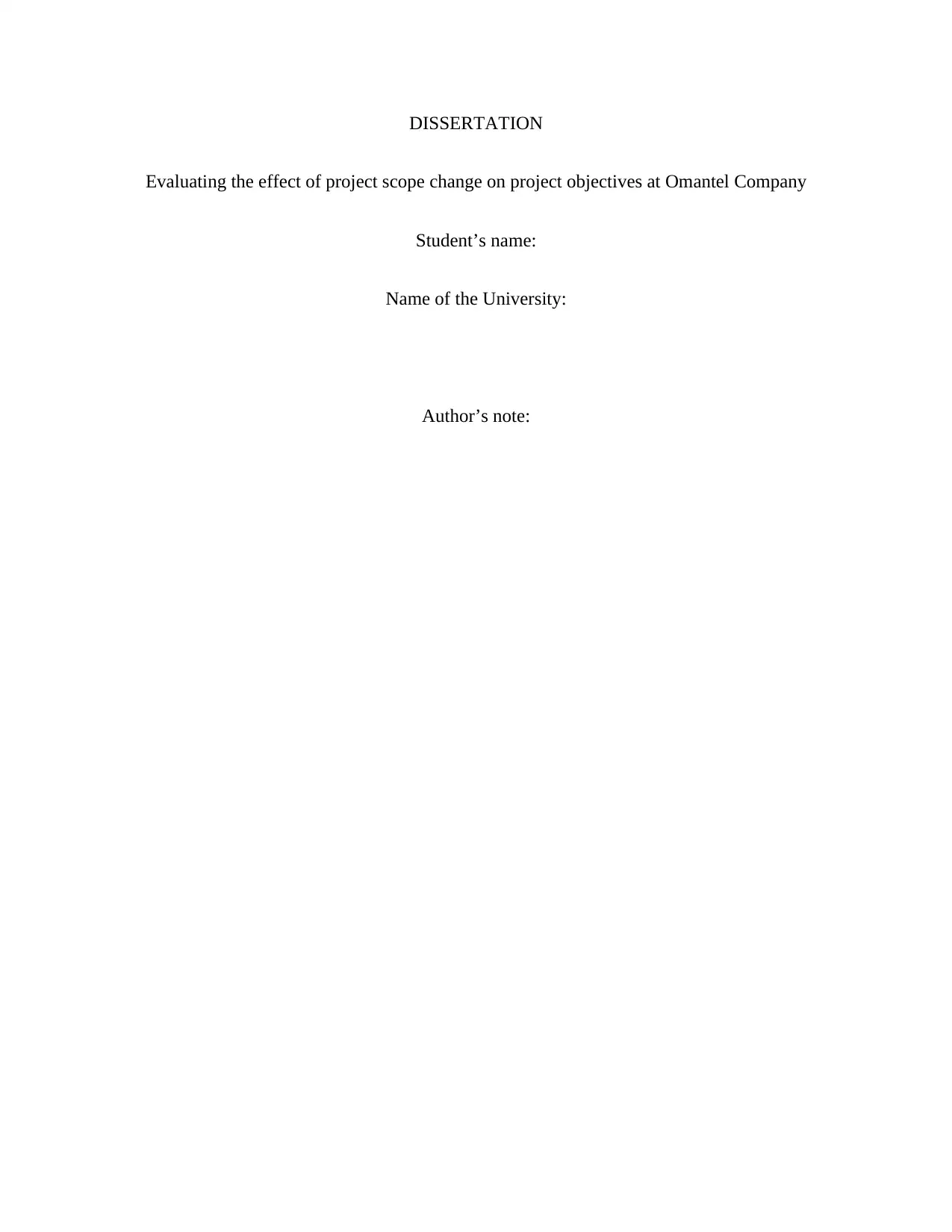
DISSERTATION
Evaluating the effect of project scope change on project objectives at Omantel Company
Student’s name:
Name of the University:
Author’s note:
Evaluating the effect of project scope change on project objectives at Omantel Company
Student’s name:
Name of the University:
Author’s note:
Secure Best Marks with AI Grader
Need help grading? Try our AI Grader for instant feedback on your assignments.
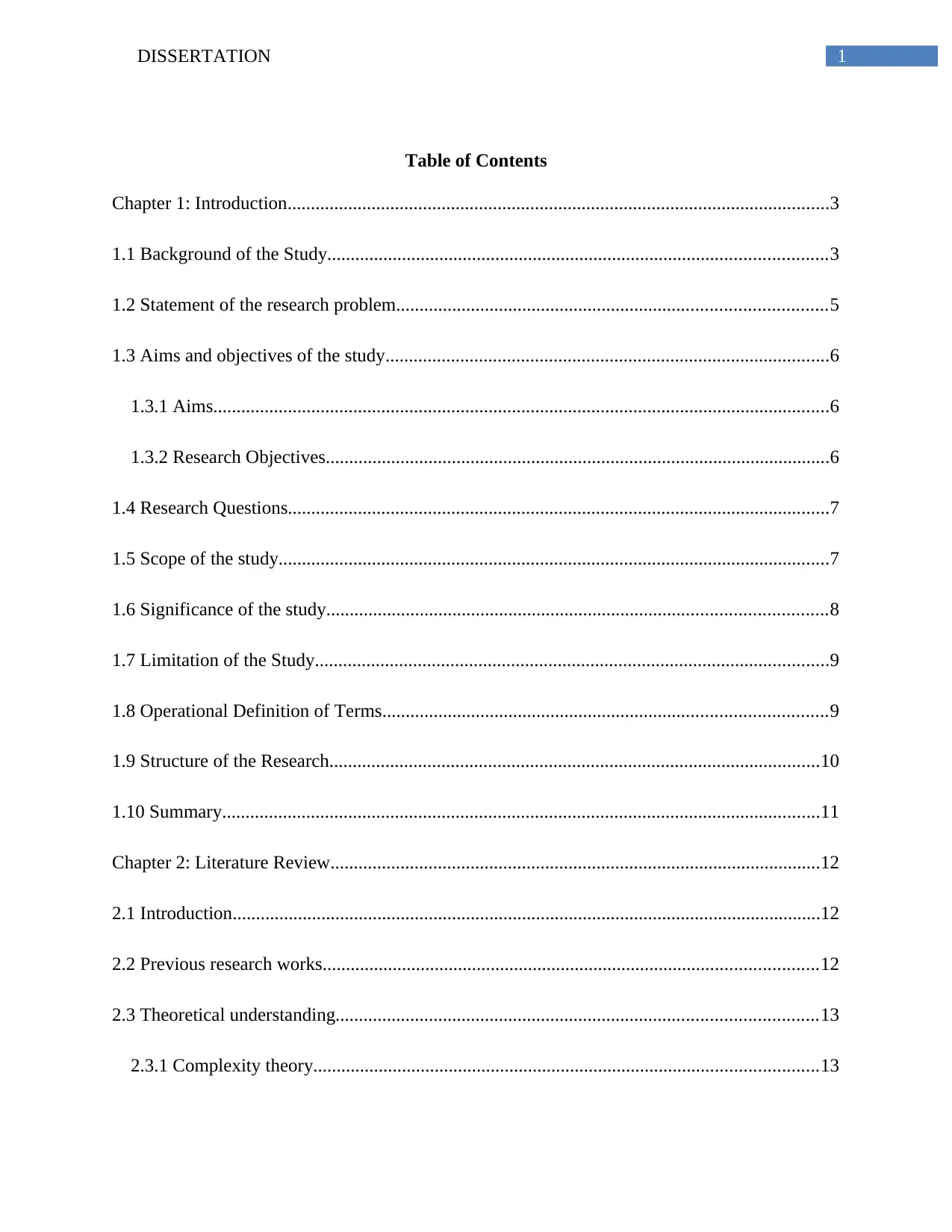
1DISSERTATION
Table of Contents
Chapter 1: Introduction....................................................................................................................3
1.1 Background of the Study...........................................................................................................3
1.2 Statement of the research problem............................................................................................5
1.3 Aims and objectives of the study...............................................................................................6
1.3.1 Aims....................................................................................................................................6
1.3.2 Research Objectives............................................................................................................6
1.4 Research Questions....................................................................................................................7
1.5 Scope of the study......................................................................................................................7
1.6 Significance of the study...........................................................................................................8
1.7 Limitation of the Study..............................................................................................................9
1.8 Operational Definition of Terms...............................................................................................9
1.9 Structure of the Research.........................................................................................................10
1.10 Summary................................................................................................................................11
Chapter 2: Literature Review.........................................................................................................12
2.1 Introduction..............................................................................................................................12
2.2 Previous research works..........................................................................................................12
2.3 Theoretical understanding.......................................................................................................13
2.3.1 Complexity theory............................................................................................................13
Table of Contents
Chapter 1: Introduction....................................................................................................................3
1.1 Background of the Study...........................................................................................................3
1.2 Statement of the research problem............................................................................................5
1.3 Aims and objectives of the study...............................................................................................6
1.3.1 Aims....................................................................................................................................6
1.3.2 Research Objectives............................................................................................................6
1.4 Research Questions....................................................................................................................7
1.5 Scope of the study......................................................................................................................7
1.6 Significance of the study...........................................................................................................8
1.7 Limitation of the Study..............................................................................................................9
1.8 Operational Definition of Terms...............................................................................................9
1.9 Structure of the Research.........................................................................................................10
1.10 Summary................................................................................................................................11
Chapter 2: Literature Review.........................................................................................................12
2.1 Introduction..............................................................................................................................12
2.2 Previous research works..........................................................................................................12
2.3 Theoretical understanding.......................................................................................................13
2.3.1 Complexity theory............................................................................................................13
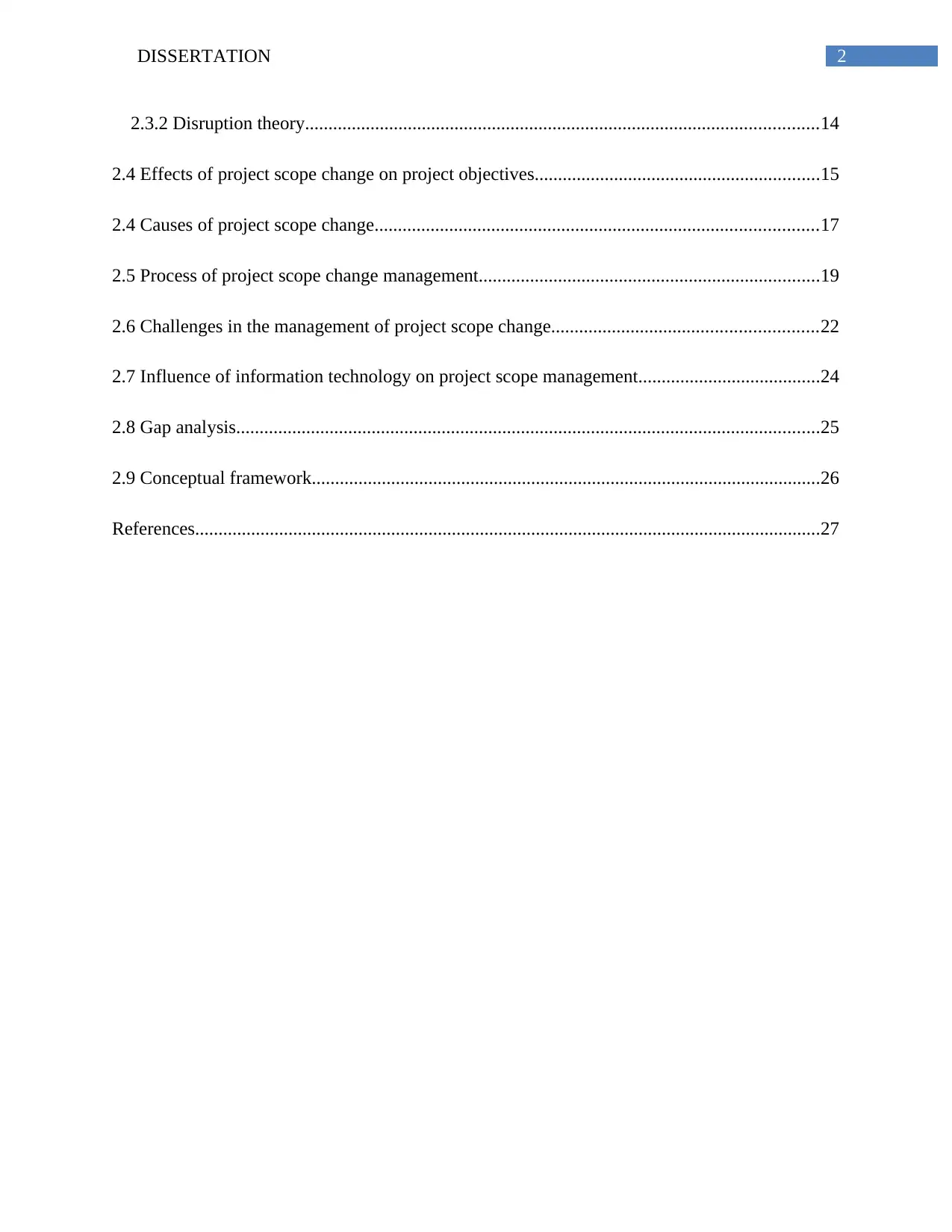
2DISSERTATION
2.3.2 Disruption theory..............................................................................................................14
2.4 Effects of project scope change on project objectives.............................................................15
2.4 Causes of project scope change...............................................................................................17
2.5 Process of project scope change management.........................................................................19
2.6 Challenges in the management of project scope change.........................................................22
2.7 Influence of information technology on project scope management.......................................24
2.8 Gap analysis.............................................................................................................................25
2.9 Conceptual framework.............................................................................................................26
References......................................................................................................................................27
2.3.2 Disruption theory..............................................................................................................14
2.4 Effects of project scope change on project objectives.............................................................15
2.4 Causes of project scope change...............................................................................................17
2.5 Process of project scope change management.........................................................................19
2.6 Challenges in the management of project scope change.........................................................22
2.7 Influence of information technology on project scope management.......................................24
2.8 Gap analysis.............................................................................................................................25
2.9 Conceptual framework.............................................................................................................26
References......................................................................................................................................27
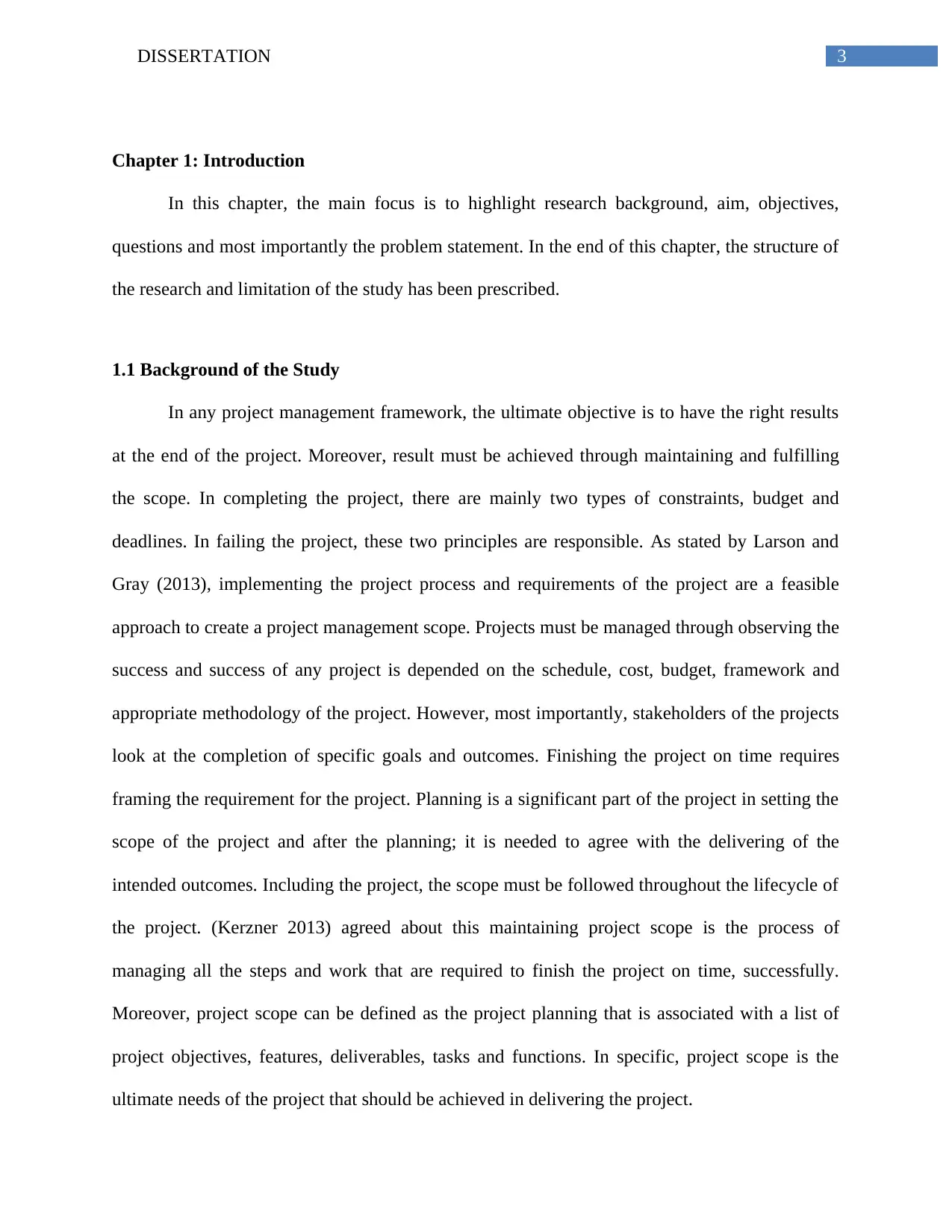
3DISSERTATION
Chapter 1: Introduction
In this chapter, the main focus is to highlight research background, aim, objectives,
questions and most importantly the problem statement. In the end of this chapter, the structure of
the research and limitation of the study has been prescribed.
1.1 Background of the Study
In any project management framework, the ultimate objective is to have the right results
at the end of the project. Moreover, result must be achieved through maintaining and fulfilling
the scope. In completing the project, there are mainly two types of constraints, budget and
deadlines. In failing the project, these two principles are responsible. As stated by Larson and
Gray (2013), implementing the project process and requirements of the project are a feasible
approach to create a project management scope. Projects must be managed through observing the
success and success of any project is depended on the schedule, cost, budget, framework and
appropriate methodology of the project. However, most importantly, stakeholders of the projects
look at the completion of specific goals and outcomes. Finishing the project on time requires
framing the requirement for the project. Planning is a significant part of the project in setting the
scope of the project and after the planning; it is needed to agree with the delivering of the
intended outcomes. Including the project, the scope must be followed throughout the lifecycle of
the project. (Kerzner 2013) agreed about this maintaining project scope is the process of
managing all the steps and work that are required to finish the project on time, successfully.
Moreover, project scope can be defined as the project planning that is associated with a list of
project objectives, features, deliverables, tasks and functions. In specific, project scope is the
ultimate needs of the project that should be achieved in delivering the project.
Chapter 1: Introduction
In this chapter, the main focus is to highlight research background, aim, objectives,
questions and most importantly the problem statement. In the end of this chapter, the structure of
the research and limitation of the study has been prescribed.
1.1 Background of the Study
In any project management framework, the ultimate objective is to have the right results
at the end of the project. Moreover, result must be achieved through maintaining and fulfilling
the scope. In completing the project, there are mainly two types of constraints, budget and
deadlines. In failing the project, these two principles are responsible. As stated by Larson and
Gray (2013), implementing the project process and requirements of the project are a feasible
approach to create a project management scope. Projects must be managed through observing the
success and success of any project is depended on the schedule, cost, budget, framework and
appropriate methodology of the project. However, most importantly, stakeholders of the projects
look at the completion of specific goals and outcomes. Finishing the project on time requires
framing the requirement for the project. Planning is a significant part of the project in setting the
scope of the project and after the planning; it is needed to agree with the delivering of the
intended outcomes. Including the project, the scope must be followed throughout the lifecycle of
the project. (Kerzner 2013) agreed about this maintaining project scope is the process of
managing all the steps and work that are required to finish the project on time, successfully.
Moreover, project scope can be defined as the project planning that is associated with a list of
project objectives, features, deliverables, tasks and functions. In specific, project scope is the
ultimate needs of the project that should be achieved in delivering the project.
Secure Best Marks with AI Grader
Need help grading? Try our AI Grader for instant feedback on your assignments.
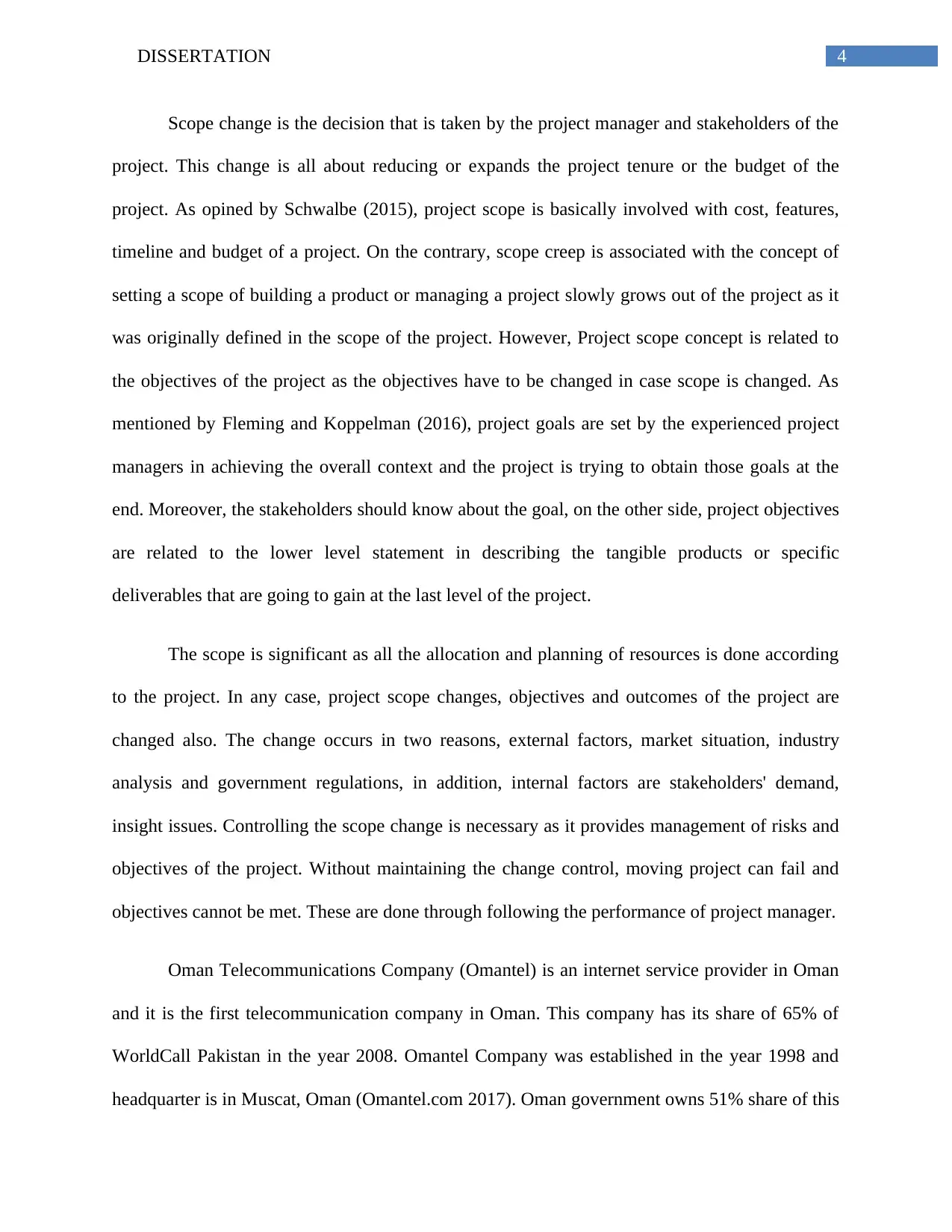
4DISSERTATION
Scope change is the decision that is taken by the project manager and stakeholders of the
project. This change is all about reducing or expands the project tenure or the budget of the
project. As opined by Schwalbe (2015), project scope is basically involved with cost, features,
timeline and budget of a project. On the contrary, scope creep is associated with the concept of
setting a scope of building a product or managing a project slowly grows out of the project as it
was originally defined in the scope of the project. However, Project scope concept is related to
the objectives of the project as the objectives have to be changed in case scope is changed. As
mentioned by Fleming and Koppelman (2016), project goals are set by the experienced project
managers in achieving the overall context and the project is trying to obtain those goals at the
end. Moreover, the stakeholders should know about the goal, on the other side, project objectives
are related to the lower level statement in describing the tangible products or specific
deliverables that are going to gain at the last level of the project.
The scope is significant as all the allocation and planning of resources is done according
to the project. In any case, project scope changes, objectives and outcomes of the project are
changed also. The change occurs in two reasons, external factors, market situation, industry
analysis and government regulations, in addition, internal factors are stakeholders' demand,
insight issues. Controlling the scope change is necessary as it provides management of risks and
objectives of the project. Without maintaining the change control, moving project can fail and
objectives cannot be met. These are done through following the performance of project manager.
Oman Telecommunications Company (Omantel) is an internet service provider in Oman
and it is the first telecommunication company in Oman. This company has its share of 65% of
WorldCall Pakistan in the year 2008. Omantel Company was established in the year 1998 and
headquarter is in Muscat, Oman (Omantel.com 2017). Oman government owns 51% share of this
Scope change is the decision that is taken by the project manager and stakeholders of the
project. This change is all about reducing or expands the project tenure or the budget of the
project. As opined by Schwalbe (2015), project scope is basically involved with cost, features,
timeline and budget of a project. On the contrary, scope creep is associated with the concept of
setting a scope of building a product or managing a project slowly grows out of the project as it
was originally defined in the scope of the project. However, Project scope concept is related to
the objectives of the project as the objectives have to be changed in case scope is changed. As
mentioned by Fleming and Koppelman (2016), project goals are set by the experienced project
managers in achieving the overall context and the project is trying to obtain those goals at the
end. Moreover, the stakeholders should know about the goal, on the other side, project objectives
are related to the lower level statement in describing the tangible products or specific
deliverables that are going to gain at the last level of the project.
The scope is significant as all the allocation and planning of resources is done according
to the project. In any case, project scope changes, objectives and outcomes of the project are
changed also. The change occurs in two reasons, external factors, market situation, industry
analysis and government regulations, in addition, internal factors are stakeholders' demand,
insight issues. Controlling the scope change is necessary as it provides management of risks and
objectives of the project. Without maintaining the change control, moving project can fail and
objectives cannot be met. These are done through following the performance of project manager.
Oman Telecommunications Company (Omantel) is an internet service provider in Oman
and it is the first telecommunication company in Oman. This company has its share of 65% of
WorldCall Pakistan in the year 2008. Omantel Company was established in the year 1998 and
headquarter is in Muscat, Oman (Omantel.com 2017). Oman government owns 51% share of this
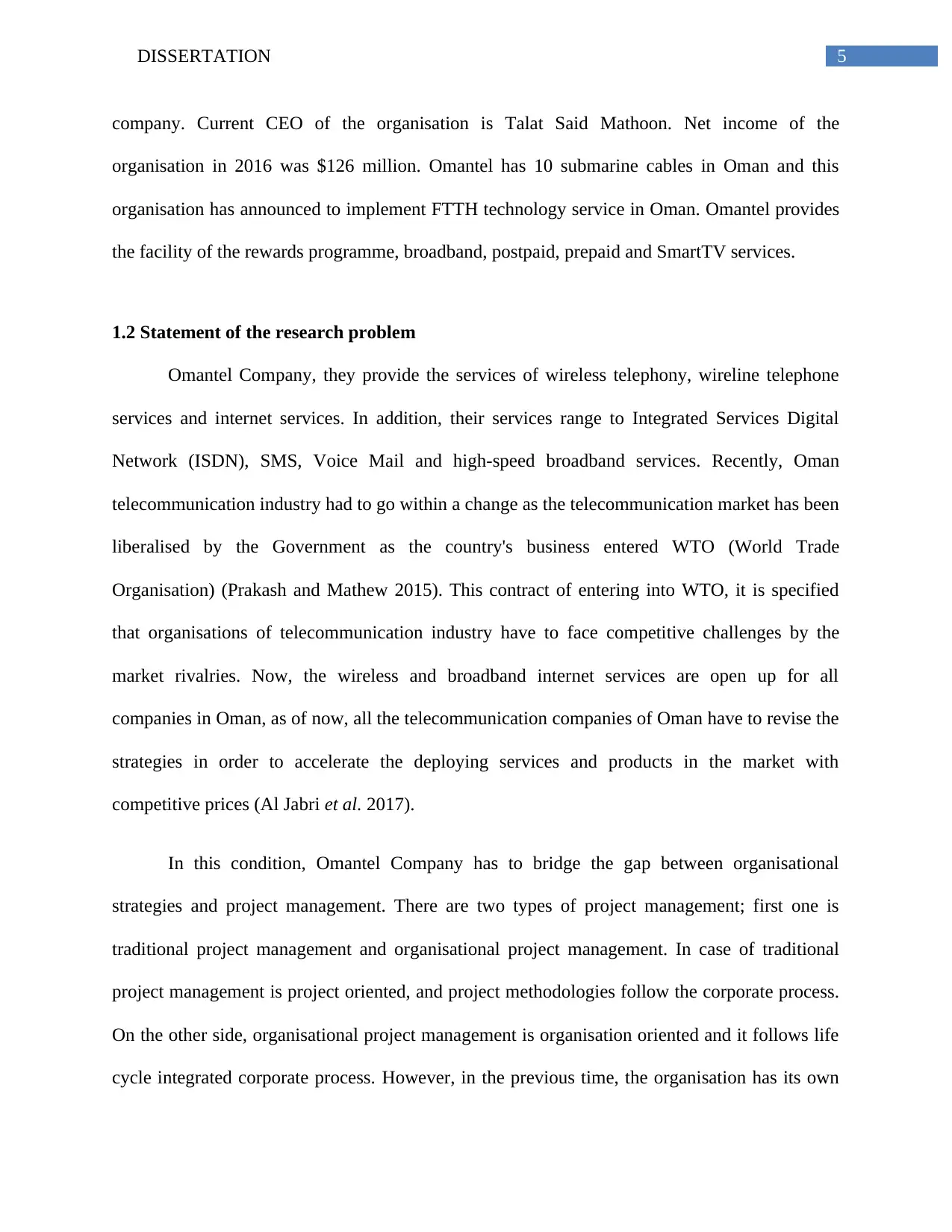
5DISSERTATION
company. Current CEO of the organisation is Talat Said Mathoon. Net income of the
organisation in 2016 was $126 million. Omantel has 10 submarine cables in Oman and this
organisation has announced to implement FTTH technology service in Oman. Omantel provides
the facility of the rewards programme, broadband, postpaid, prepaid and SmartTV services.
1.2 Statement of the research problem
Omantel Company, they provide the services of wireless telephony, wireline telephone
services and internet services. In addition, their services range to Integrated Services Digital
Network (ISDN), SMS, Voice Mail and high-speed broadband services. Recently, Oman
telecommunication industry had to go within a change as the telecommunication market has been
liberalised by the Government as the country's business entered WTO (World Trade
Organisation) (Prakash and Mathew 2015). This contract of entering into WTO, it is specified
that organisations of telecommunication industry have to face competitive challenges by the
market rivalries. Now, the wireless and broadband internet services are open up for all
companies in Oman, as of now, all the telecommunication companies of Oman have to revise the
strategies in order to accelerate the deploying services and products in the market with
competitive prices (Al Jabri et al. 2017).
In this condition, Omantel Company has to bridge the gap between organisational
strategies and project management. There are two types of project management; first one is
traditional project management and organisational project management. In case of traditional
project management is project oriented, and project methodologies follow the corporate process.
On the other side, organisational project management is organisation oriented and it follows life
cycle integrated corporate process. However, in the previous time, the organisation has its own
company. Current CEO of the organisation is Talat Said Mathoon. Net income of the
organisation in 2016 was $126 million. Omantel has 10 submarine cables in Oman and this
organisation has announced to implement FTTH technology service in Oman. Omantel provides
the facility of the rewards programme, broadband, postpaid, prepaid and SmartTV services.
1.2 Statement of the research problem
Omantel Company, they provide the services of wireless telephony, wireline telephone
services and internet services. In addition, their services range to Integrated Services Digital
Network (ISDN), SMS, Voice Mail and high-speed broadband services. Recently, Oman
telecommunication industry had to go within a change as the telecommunication market has been
liberalised by the Government as the country's business entered WTO (World Trade
Organisation) (Prakash and Mathew 2015). This contract of entering into WTO, it is specified
that organisations of telecommunication industry have to face competitive challenges by the
market rivalries. Now, the wireless and broadband internet services are open up for all
companies in Oman, as of now, all the telecommunication companies of Oman have to revise the
strategies in order to accelerate the deploying services and products in the market with
competitive prices (Al Jabri et al. 2017).
In this condition, Omantel Company has to bridge the gap between organisational
strategies and project management. There are two types of project management; first one is
traditional project management and organisational project management. In case of traditional
project management is project oriented, and project methodologies follow the corporate process.
On the other side, organisational project management is organisation oriented and it follows life
cycle integrated corporate process. However, in the previous time, the organisation has its own
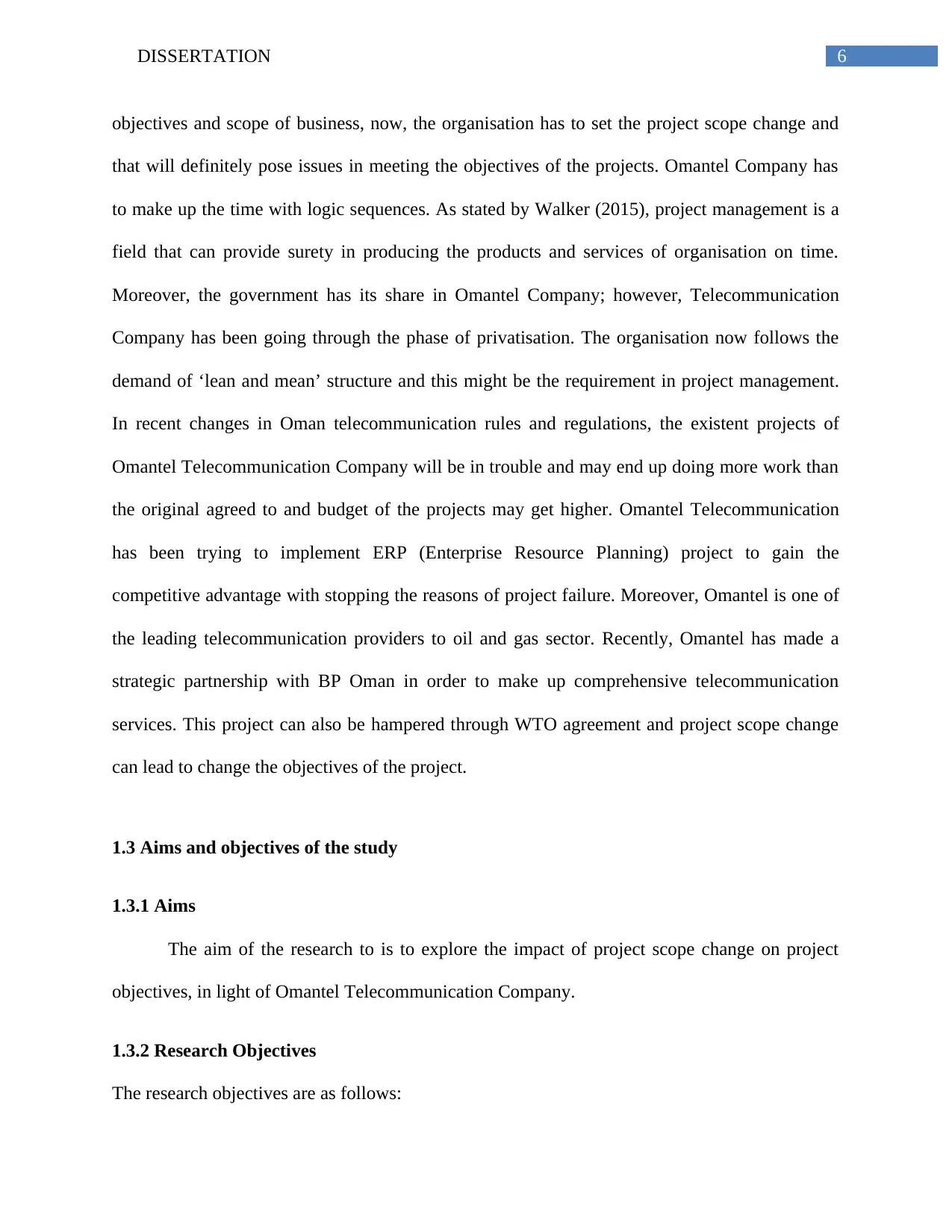
6DISSERTATION
objectives and scope of business, now, the organisation has to set the project scope change and
that will definitely pose issues in meeting the objectives of the projects. Omantel Company has
to make up the time with logic sequences. As stated by Walker (2015), project management is a
field that can provide surety in producing the products and services of organisation on time.
Moreover, the government has its share in Omantel Company; however, Telecommunication
Company has been going through the phase of privatisation. The organisation now follows the
demand of ‘lean and mean’ structure and this might be the requirement in project management.
In recent changes in Oman telecommunication rules and regulations, the existent projects of
Omantel Telecommunication Company will be in trouble and may end up doing more work than
the original agreed to and budget of the projects may get higher. Omantel Telecommunication
has been trying to implement ERP (Enterprise Resource Planning) project to gain the
competitive advantage with stopping the reasons of project failure. Moreover, Omantel is one of
the leading telecommunication providers to oil and gas sector. Recently, Omantel has made a
strategic partnership with BP Oman in order to make up comprehensive telecommunication
services. This project can also be hampered through WTO agreement and project scope change
can lead to change the objectives of the project.
1.3 Aims and objectives of the study
1.3.1 Aims
The aim of the research to is to explore the impact of project scope change on project
objectives, in light of Omantel Telecommunication Company.
1.3.2 Research Objectives
The research objectives are as follows:
objectives and scope of business, now, the organisation has to set the project scope change and
that will definitely pose issues in meeting the objectives of the projects. Omantel Company has
to make up the time with logic sequences. As stated by Walker (2015), project management is a
field that can provide surety in producing the products and services of organisation on time.
Moreover, the government has its share in Omantel Company; however, Telecommunication
Company has been going through the phase of privatisation. The organisation now follows the
demand of ‘lean and mean’ structure and this might be the requirement in project management.
In recent changes in Oman telecommunication rules and regulations, the existent projects of
Omantel Telecommunication Company will be in trouble and may end up doing more work than
the original agreed to and budget of the projects may get higher. Omantel Telecommunication
has been trying to implement ERP (Enterprise Resource Planning) project to gain the
competitive advantage with stopping the reasons of project failure. Moreover, Omantel is one of
the leading telecommunication providers to oil and gas sector. Recently, Omantel has made a
strategic partnership with BP Oman in order to make up comprehensive telecommunication
services. This project can also be hampered through WTO agreement and project scope change
can lead to change the objectives of the project.
1.3 Aims and objectives of the study
1.3.1 Aims
The aim of the research to is to explore the impact of project scope change on project
objectives, in light of Omantel Telecommunication Company.
1.3.2 Research Objectives
The research objectives are as follows:
Paraphrase This Document
Need a fresh take? Get an instant paraphrase of this document with our AI Paraphraser
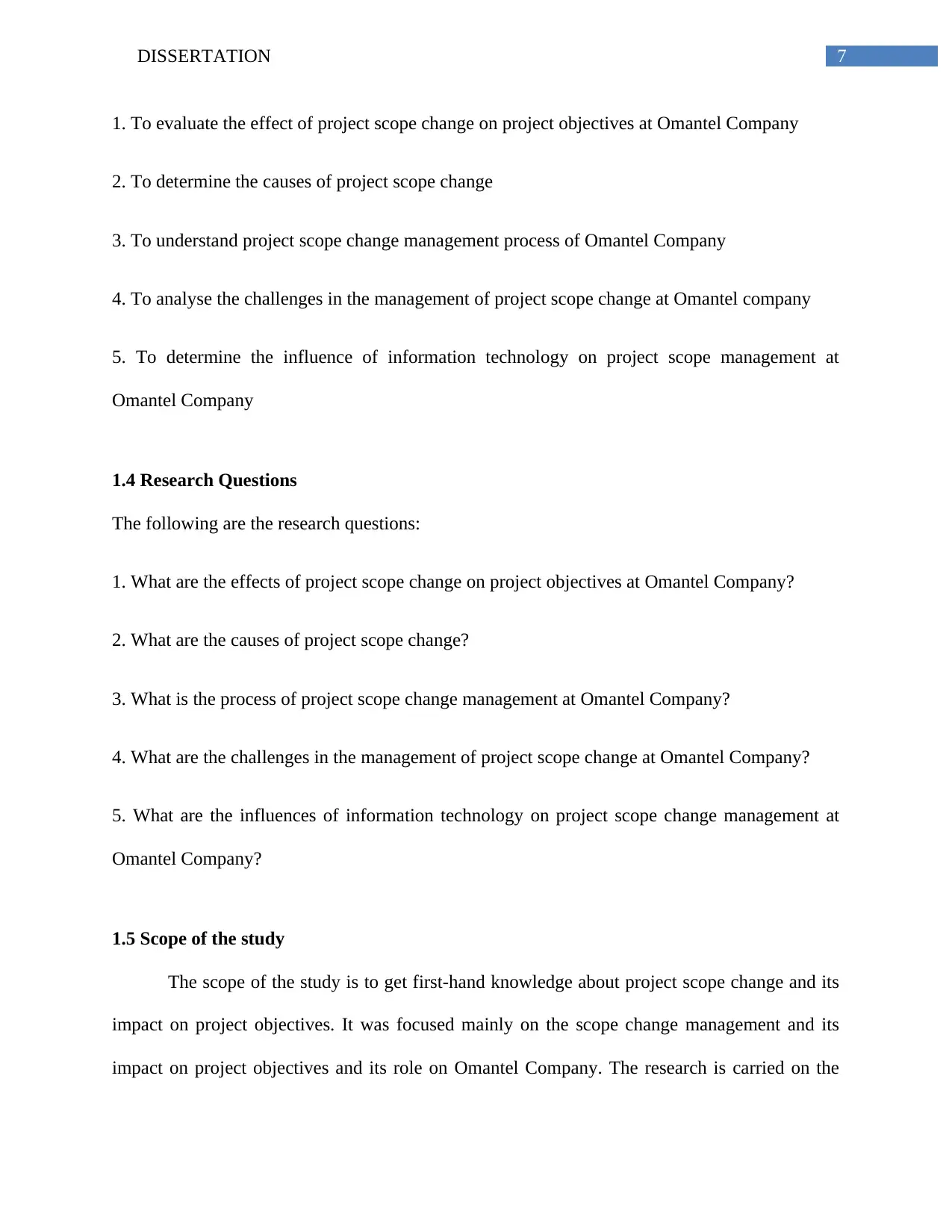
7DISSERTATION
1. To evaluate the effect of project scope change on project objectives at Omantel Company
2. To determine the causes of project scope change
3. To understand project scope change management process of Omantel Company
4. To analyse the challenges in the management of project scope change at Omantel company
5. To determine the influence of information technology on project scope management at
Omantel Company
1.4 Research Questions
The following are the research questions:
1. What are the effects of project scope change on project objectives at Omantel Company?
2. What are the causes of project scope change?
3. What is the process of project scope change management at Omantel Company?
4. What are the challenges in the management of project scope change at Omantel Company?
5. What are the influences of information technology on project scope change management at
Omantel Company?
1.5 Scope of the study
The scope of the study is to get first-hand knowledge about project scope change and its
impact on project objectives. It was focused mainly on the scope change management and its
impact on project objectives and its role on Omantel Company. The research is carried on the
1. To evaluate the effect of project scope change on project objectives at Omantel Company
2. To determine the causes of project scope change
3. To understand project scope change management process of Omantel Company
4. To analyse the challenges in the management of project scope change at Omantel company
5. To determine the influence of information technology on project scope management at
Omantel Company
1.4 Research Questions
The following are the research questions:
1. What are the effects of project scope change on project objectives at Omantel Company?
2. What are the causes of project scope change?
3. What is the process of project scope change management at Omantel Company?
4. What are the challenges in the management of project scope change at Omantel Company?
5. What are the influences of information technology on project scope change management at
Omantel Company?
1.5 Scope of the study
The scope of the study is to get first-hand knowledge about project scope change and its
impact on project objectives. It was focused mainly on the scope change management and its
impact on project objectives and its role on Omantel Company. The research is carried on the
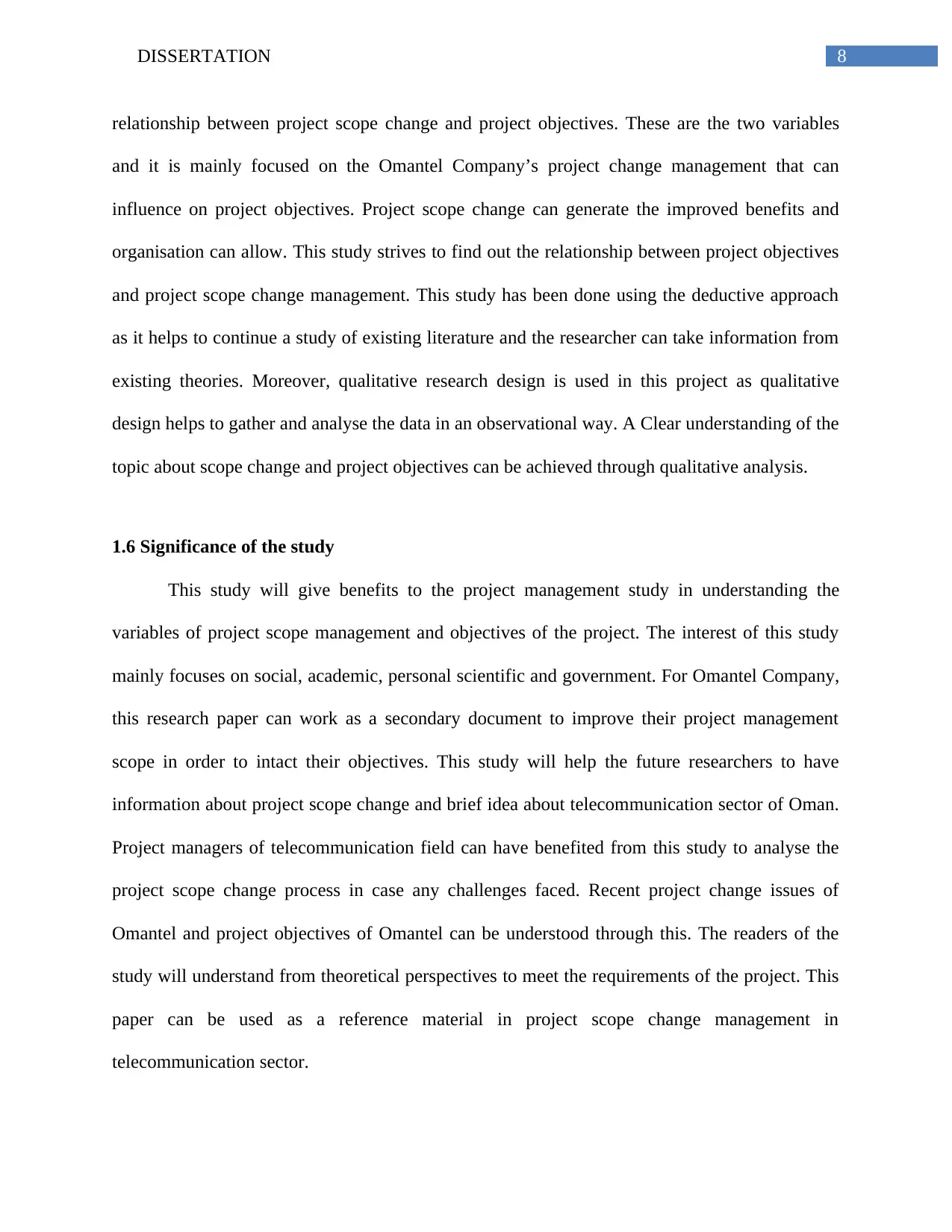
8DISSERTATION
relationship between project scope change and project objectives. These are the two variables
and it is mainly focused on the Omantel Company’s project change management that can
influence on project objectives. Project scope change can generate the improved benefits and
organisation can allow. This study strives to find out the relationship between project objectives
and project scope change management. This study has been done using the deductive approach
as it helps to continue a study of existing literature and the researcher can take information from
existing theories. Moreover, qualitative research design is used in this project as qualitative
design helps to gather and analyse the data in an observational way. A Clear understanding of the
topic about scope change and project objectives can be achieved through qualitative analysis.
1.6 Significance of the study
This study will give benefits to the project management study in understanding the
variables of project scope management and objectives of the project. The interest of this study
mainly focuses on social, academic, personal scientific and government. For Omantel Company,
this research paper can work as a secondary document to improve their project management
scope in order to intact their objectives. This study will help the future researchers to have
information about project scope change and brief idea about telecommunication sector of Oman.
Project managers of telecommunication field can have benefited from this study to analyse the
project scope change process in case any challenges faced. Recent project change issues of
Omantel and project objectives of Omantel can be understood through this. The readers of the
study will understand from theoretical perspectives to meet the requirements of the project. This
paper can be used as a reference material in project scope change management in
telecommunication sector.
relationship between project scope change and project objectives. These are the two variables
and it is mainly focused on the Omantel Company’s project change management that can
influence on project objectives. Project scope change can generate the improved benefits and
organisation can allow. This study strives to find out the relationship between project objectives
and project scope change management. This study has been done using the deductive approach
as it helps to continue a study of existing literature and the researcher can take information from
existing theories. Moreover, qualitative research design is used in this project as qualitative
design helps to gather and analyse the data in an observational way. A Clear understanding of the
topic about scope change and project objectives can be achieved through qualitative analysis.
1.6 Significance of the study
This study will give benefits to the project management study in understanding the
variables of project scope management and objectives of the project. The interest of this study
mainly focuses on social, academic, personal scientific and government. For Omantel Company,
this research paper can work as a secondary document to improve their project management
scope in order to intact their objectives. This study will help the future researchers to have
information about project scope change and brief idea about telecommunication sector of Oman.
Project managers of telecommunication field can have benefited from this study to analyse the
project scope change process in case any challenges faced. Recent project change issues of
Omantel and project objectives of Omantel can be understood through this. The readers of the
study will understand from theoretical perspectives to meet the requirements of the project. This
paper can be used as a reference material in project scope change management in
telecommunication sector.
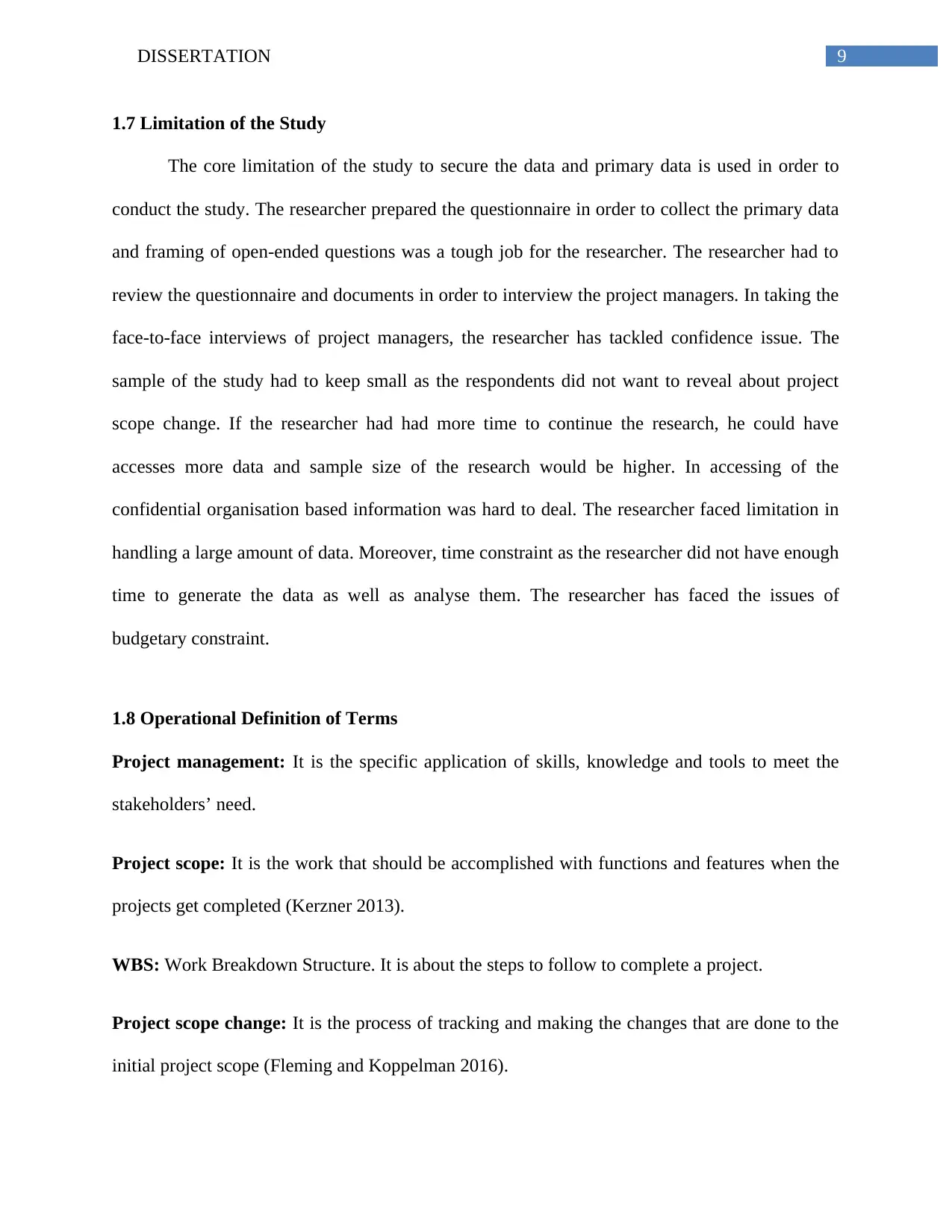
9DISSERTATION
1.7 Limitation of the Study
The core limitation of the study to secure the data and primary data is used in order to
conduct the study. The researcher prepared the questionnaire in order to collect the primary data
and framing of open-ended questions was a tough job for the researcher. The researcher had to
review the questionnaire and documents in order to interview the project managers. In taking the
face-to-face interviews of project managers, the researcher has tackled confidence issue. The
sample of the study had to keep small as the respondents did not want to reveal about project
scope change. If the researcher had had more time to continue the research, he could have
accesses more data and sample size of the research would be higher. In accessing of the
confidential organisation based information was hard to deal. The researcher faced limitation in
handling a large amount of data. Moreover, time constraint as the researcher did not have enough
time to generate the data as well as analyse them. The researcher has faced the issues of
budgetary constraint.
1.8 Operational Definition of Terms
Project management: It is the specific application of skills, knowledge and tools to meet the
stakeholders’ need.
Project scope: It is the work that should be accomplished with functions and features when the
projects get completed (Kerzner 2013).
WBS: Work Breakdown Structure. It is about the steps to follow to complete a project.
Project scope change: It is the process of tracking and making the changes that are done to the
initial project scope (Fleming and Koppelman 2016).
1.7 Limitation of the Study
The core limitation of the study to secure the data and primary data is used in order to
conduct the study. The researcher prepared the questionnaire in order to collect the primary data
and framing of open-ended questions was a tough job for the researcher. The researcher had to
review the questionnaire and documents in order to interview the project managers. In taking the
face-to-face interviews of project managers, the researcher has tackled confidence issue. The
sample of the study had to keep small as the respondents did not want to reveal about project
scope change. If the researcher had had more time to continue the research, he could have
accesses more data and sample size of the research would be higher. In accessing of the
confidential organisation based information was hard to deal. The researcher faced limitation in
handling a large amount of data. Moreover, time constraint as the researcher did not have enough
time to generate the data as well as analyse them. The researcher has faced the issues of
budgetary constraint.
1.8 Operational Definition of Terms
Project management: It is the specific application of skills, knowledge and tools to meet the
stakeholders’ need.
Project scope: It is the work that should be accomplished with functions and features when the
projects get completed (Kerzner 2013).
WBS: Work Breakdown Structure. It is about the steps to follow to complete a project.
Project scope change: It is the process of tracking and making the changes that are done to the
initial project scope (Fleming and Koppelman 2016).
Secure Best Marks with AI Grader
Need help grading? Try our AI Grader for instant feedback on your assignments.
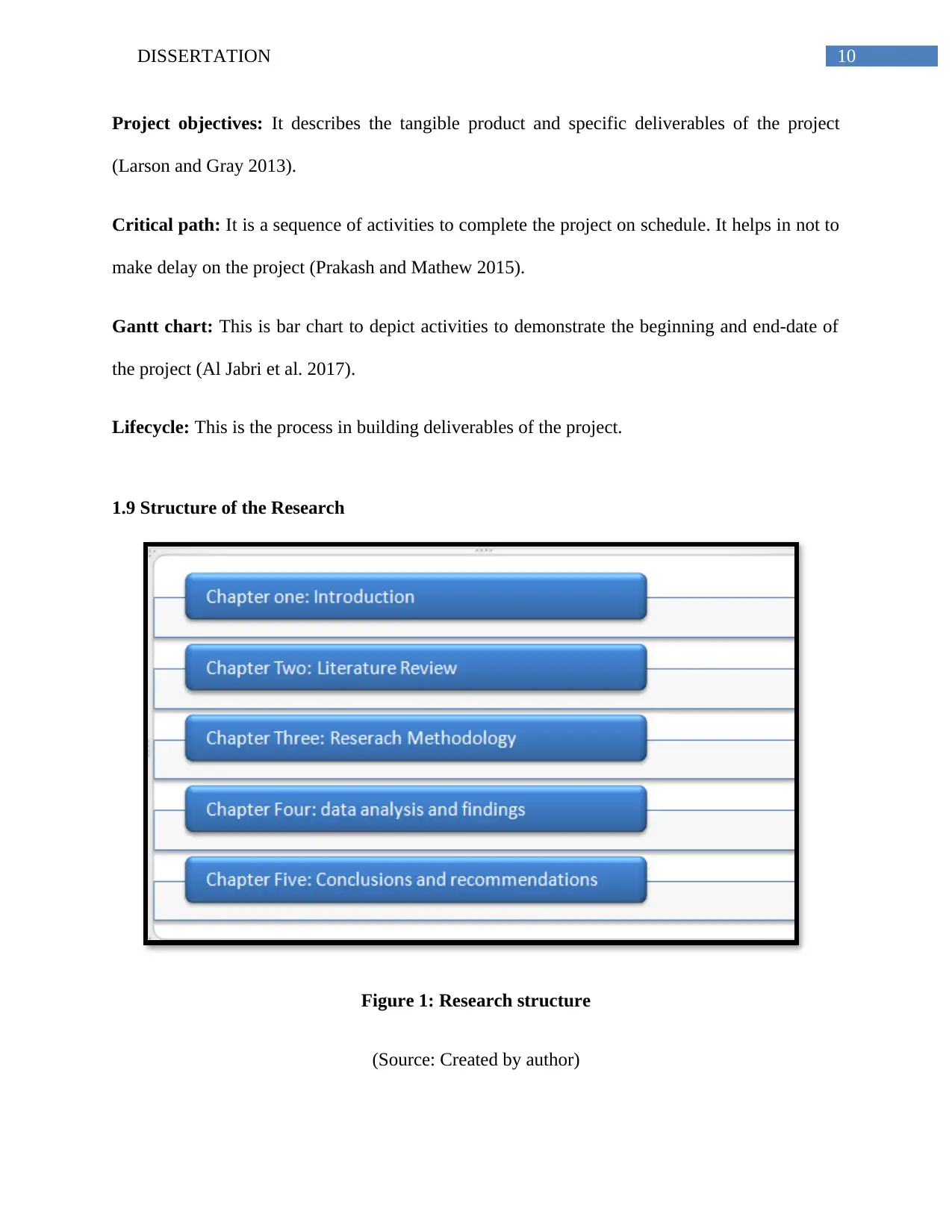
10DISSERTATION
Project objectives: It describes the tangible product and specific deliverables of the project
(Larson and Gray 2013).
Critical path: It is a sequence of activities to complete the project on schedule. It helps in not to
make delay on the project (Prakash and Mathew 2015).
Gantt chart: This is bar chart to depict activities to demonstrate the beginning and end-date of
the project (Al Jabri et al. 2017).
Lifecycle: This is the process in building deliverables of the project.
1.9 Structure of the Research
Figure 1: Research structure
(Source: Created by author)
Project objectives: It describes the tangible product and specific deliverables of the project
(Larson and Gray 2013).
Critical path: It is a sequence of activities to complete the project on schedule. It helps in not to
make delay on the project (Prakash and Mathew 2015).
Gantt chart: This is bar chart to depict activities to demonstrate the beginning and end-date of
the project (Al Jabri et al. 2017).
Lifecycle: This is the process in building deliverables of the project.
1.9 Structure of the Research
Figure 1: Research structure
(Source: Created by author)
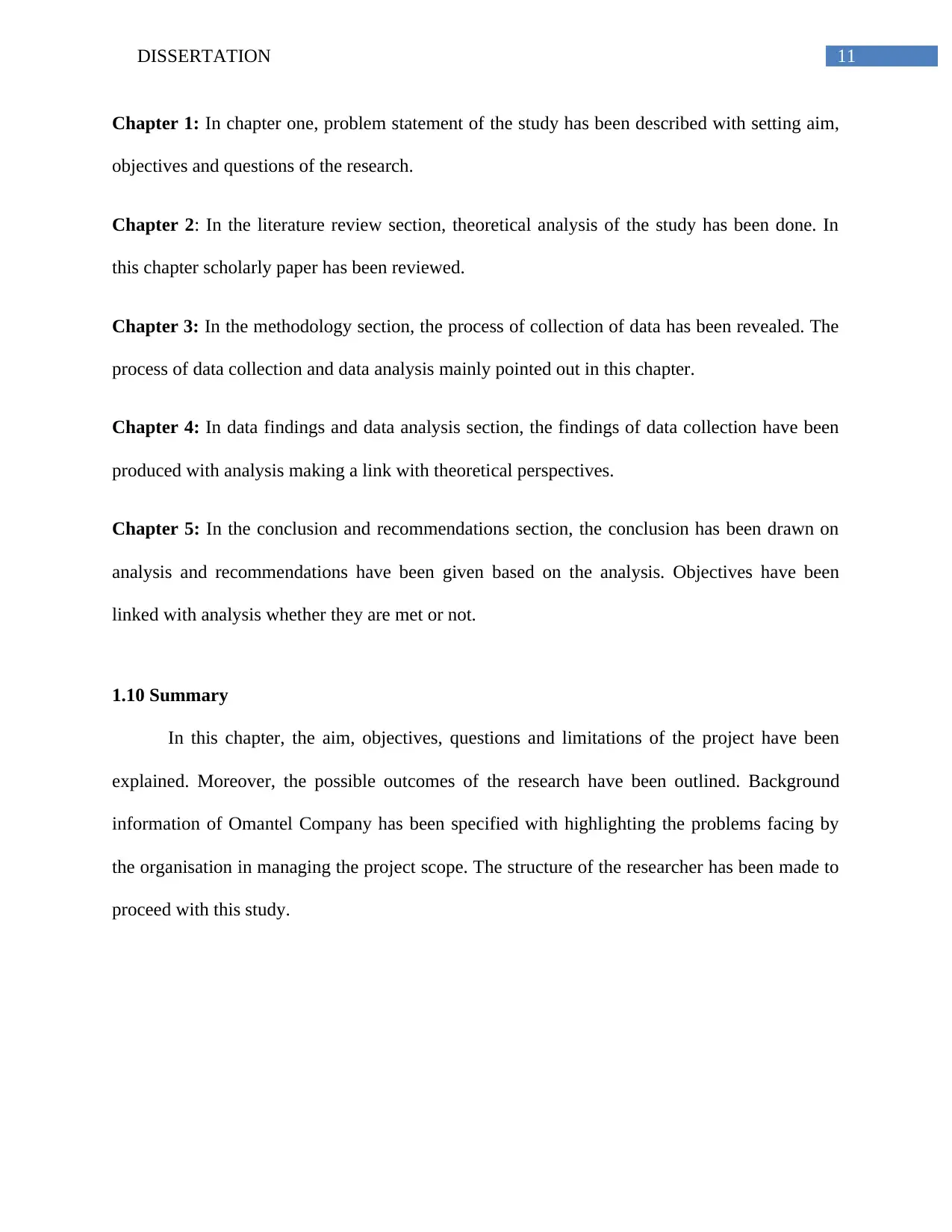
11DISSERTATION
Chapter 1: In chapter one, problem statement of the study has been described with setting aim,
objectives and questions of the research.
Chapter 2: In the literature review section, theoretical analysis of the study has been done. In
this chapter scholarly paper has been reviewed.
Chapter 3: In the methodology section, the process of collection of data has been revealed. The
process of data collection and data analysis mainly pointed out in this chapter.
Chapter 4: In data findings and data analysis section, the findings of data collection have been
produced with analysis making a link with theoretical perspectives.
Chapter 5: In the conclusion and recommendations section, the conclusion has been drawn on
analysis and recommendations have been given based on the analysis. Objectives have been
linked with analysis whether they are met or not.
1.10 Summary
In this chapter, the aim, objectives, questions and limitations of the project have been
explained. Moreover, the possible outcomes of the research have been outlined. Background
information of Omantel Company has been specified with highlighting the problems facing by
the organisation in managing the project scope. The structure of the researcher has been made to
proceed with this study.
Chapter 1: In chapter one, problem statement of the study has been described with setting aim,
objectives and questions of the research.
Chapter 2: In the literature review section, theoretical analysis of the study has been done. In
this chapter scholarly paper has been reviewed.
Chapter 3: In the methodology section, the process of collection of data has been revealed. The
process of data collection and data analysis mainly pointed out in this chapter.
Chapter 4: In data findings and data analysis section, the findings of data collection have been
produced with analysis making a link with theoretical perspectives.
Chapter 5: In the conclusion and recommendations section, the conclusion has been drawn on
analysis and recommendations have been given based on the analysis. Objectives have been
linked with analysis whether they are met or not.
1.10 Summary
In this chapter, the aim, objectives, questions and limitations of the project have been
explained. Moreover, the possible outcomes of the research have been outlined. Background
information of Omantel Company has been specified with highlighting the problems facing by
the organisation in managing the project scope. The structure of the researcher has been made to
proceed with this study.
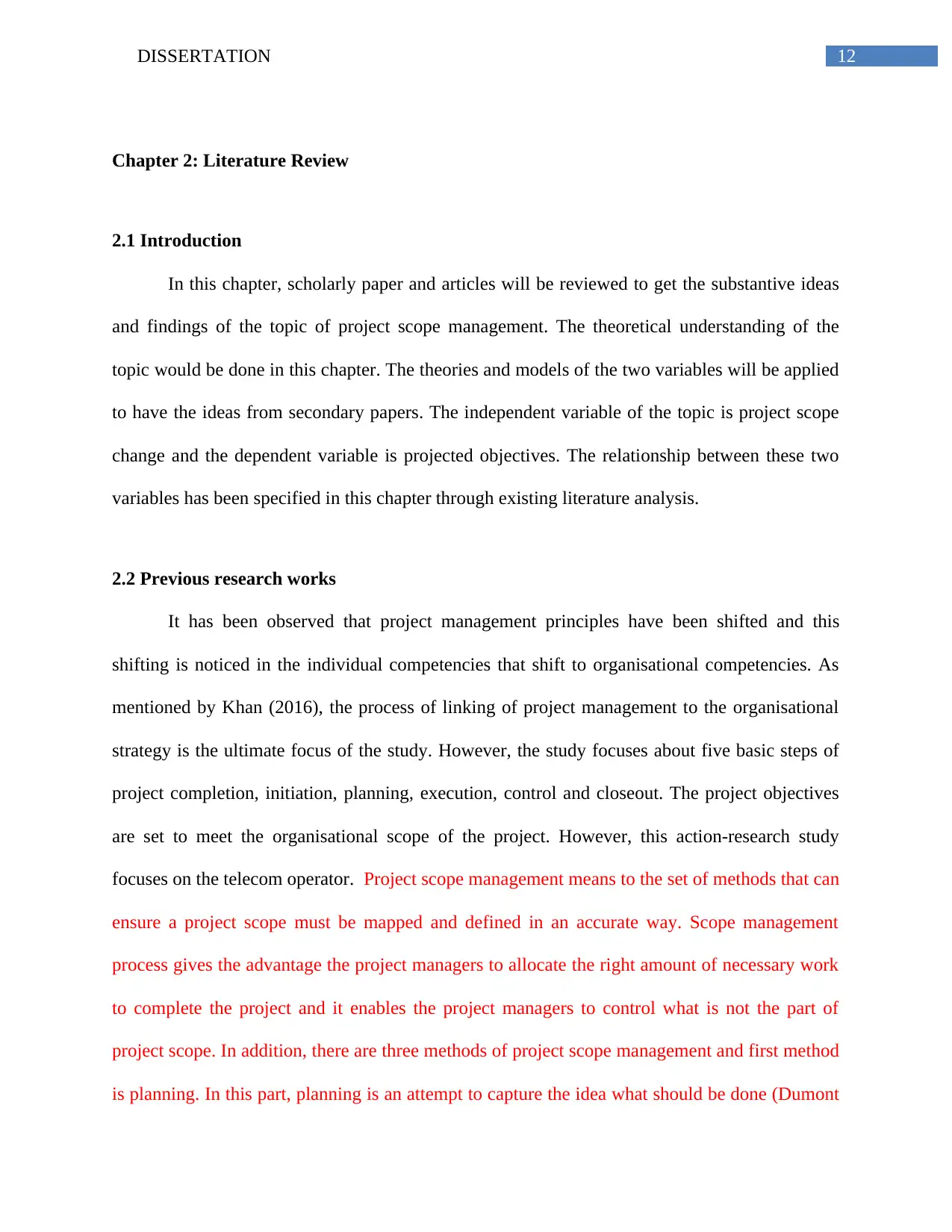
12DISSERTATION
Chapter 2: Literature Review
2.1 Introduction
In this chapter, scholarly paper and articles will be reviewed to get the substantive ideas
and findings of the topic of project scope management. The theoretical understanding of the
topic would be done in this chapter. The theories and models of the two variables will be applied
to have the ideas from secondary papers. The independent variable of the topic is project scope
change and the dependent variable is projected objectives. The relationship between these two
variables has been specified in this chapter through existing literature analysis.
2.2 Previous research works
It has been observed that project management principles have been shifted and this
shifting is noticed in the individual competencies that shift to organisational competencies. As
mentioned by Khan (2016), the process of linking of project management to the organisational
strategy is the ultimate focus of the study. However, the study focuses about five basic steps of
project completion, initiation, planning, execution, control and closeout. The project objectives
are set to meet the organisational scope of the project. However, this action-research study
focuses on the telecom operator. Project scope management means to the set of methods that can
ensure a project scope must be mapped and defined in an accurate way. Scope management
process gives the advantage the project managers to allocate the right amount of necessary work
to complete the project and it enables the project managers to control what is not the part of
project scope. In addition, there are three methods of project scope management and first method
is planning. In this part, planning is an attempt to capture the idea what should be done (Dumont
Chapter 2: Literature Review
2.1 Introduction
In this chapter, scholarly paper and articles will be reviewed to get the substantive ideas
and findings of the topic of project scope management. The theoretical understanding of the
topic would be done in this chapter. The theories and models of the two variables will be applied
to have the ideas from secondary papers. The independent variable of the topic is project scope
change and the dependent variable is projected objectives. The relationship between these two
variables has been specified in this chapter through existing literature analysis.
2.2 Previous research works
It has been observed that project management principles have been shifted and this
shifting is noticed in the individual competencies that shift to organisational competencies. As
mentioned by Khan (2016), the process of linking of project management to the organisational
strategy is the ultimate focus of the study. However, the study focuses about five basic steps of
project completion, initiation, planning, execution, control and closeout. The project objectives
are set to meet the organisational scope of the project. However, this action-research study
focuses on the telecom operator. Project scope management means to the set of methods that can
ensure a project scope must be mapped and defined in an accurate way. Scope management
process gives the advantage the project managers to allocate the right amount of necessary work
to complete the project and it enables the project managers to control what is not the part of
project scope. In addition, there are three methods of project scope management and first method
is planning. In this part, planning is an attempt to capture the idea what should be done (Dumont
Paraphrase This Document
Need a fresh take? Get an instant paraphrase of this document with our AI Paraphraser
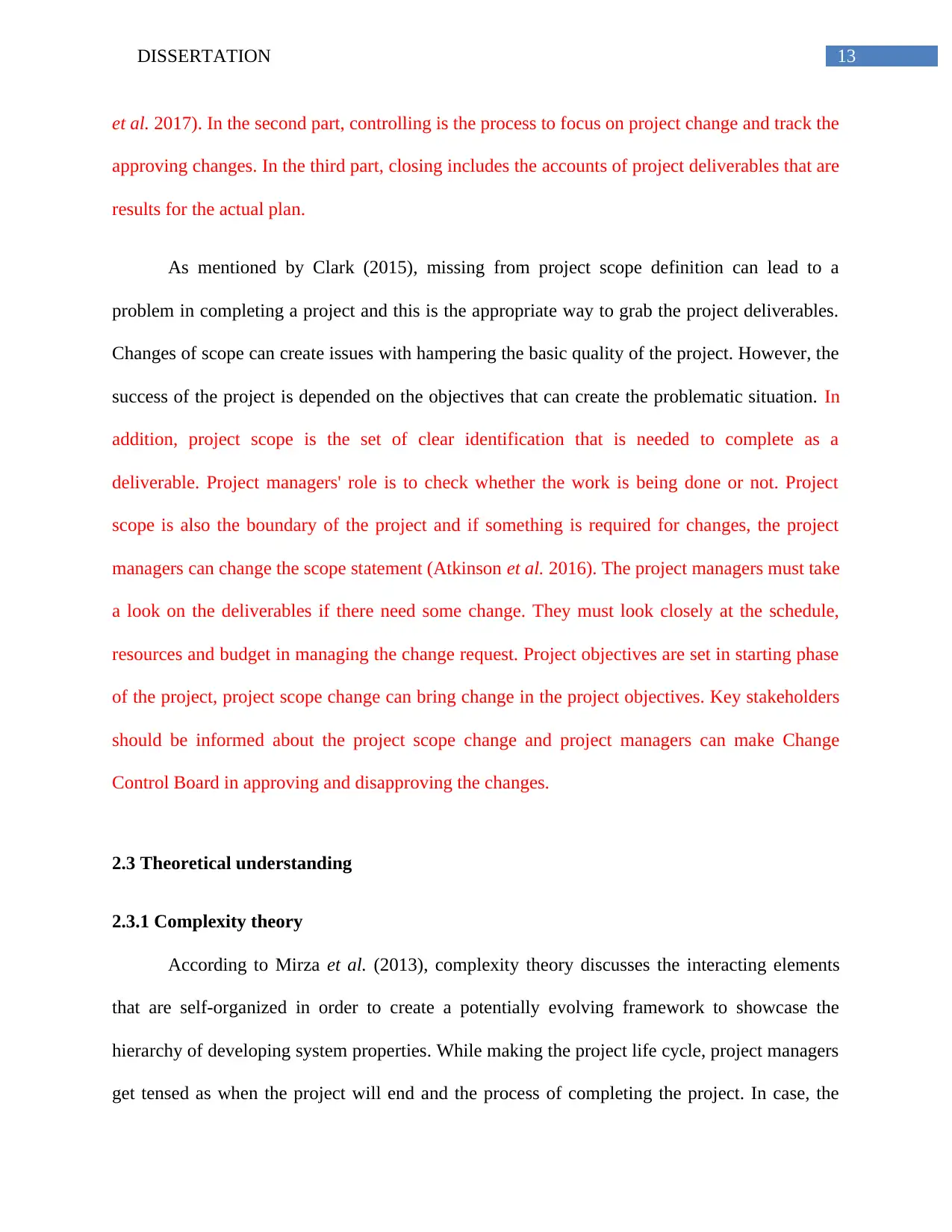
13DISSERTATION
et al. 2017). In the second part, controlling is the process to focus on project change and track the
approving changes. In the third part, closing includes the accounts of project deliverables that are
results for the actual plan.
As mentioned by Clark (2015), missing from project scope definition can lead to a
problem in completing a project and this is the appropriate way to grab the project deliverables.
Changes of scope can create issues with hampering the basic quality of the project. However, the
success of the project is depended on the objectives that can create the problematic situation. In
addition, project scope is the set of clear identification that is needed to complete as a
deliverable. Project managers' role is to check whether the work is being done or not. Project
scope is also the boundary of the project and if something is required for changes, the project
managers can change the scope statement (Atkinson et al. 2016). The project managers must take
a look on the deliverables if there need some change. They must look closely at the schedule,
resources and budget in managing the change request. Project objectives are set in starting phase
of the project, project scope change can bring change in the project objectives. Key stakeholders
should be informed about the project scope change and project managers can make Change
Control Board in approving and disapproving the changes.
2.3 Theoretical understanding
2.3.1 Complexity theory
According to Mirza et al. (2013), complexity theory discusses the interacting elements
that are self-organized in order to create a potentially evolving framework to showcase the
hierarchy of developing system properties. While making the project life cycle, project managers
get tensed as when the project will end and the process of completing the project. In case, the
et al. 2017). In the second part, controlling is the process to focus on project change and track the
approving changes. In the third part, closing includes the accounts of project deliverables that are
results for the actual plan.
As mentioned by Clark (2015), missing from project scope definition can lead to a
problem in completing a project and this is the appropriate way to grab the project deliverables.
Changes of scope can create issues with hampering the basic quality of the project. However, the
success of the project is depended on the objectives that can create the problematic situation. In
addition, project scope is the set of clear identification that is needed to complete as a
deliverable. Project managers' role is to check whether the work is being done or not. Project
scope is also the boundary of the project and if something is required for changes, the project
managers can change the scope statement (Atkinson et al. 2016). The project managers must take
a look on the deliverables if there need some change. They must look closely at the schedule,
resources and budget in managing the change request. Project objectives are set in starting phase
of the project, project scope change can bring change in the project objectives. Key stakeholders
should be informed about the project scope change and project managers can make Change
Control Board in approving and disapproving the changes.
2.3 Theoretical understanding
2.3.1 Complexity theory
According to Mirza et al. (2013), complexity theory discusses the interacting elements
that are self-organized in order to create a potentially evolving framework to showcase the
hierarchy of developing system properties. While making the project life cycle, project managers
get tensed as when the project will end and the process of completing the project. In case, the
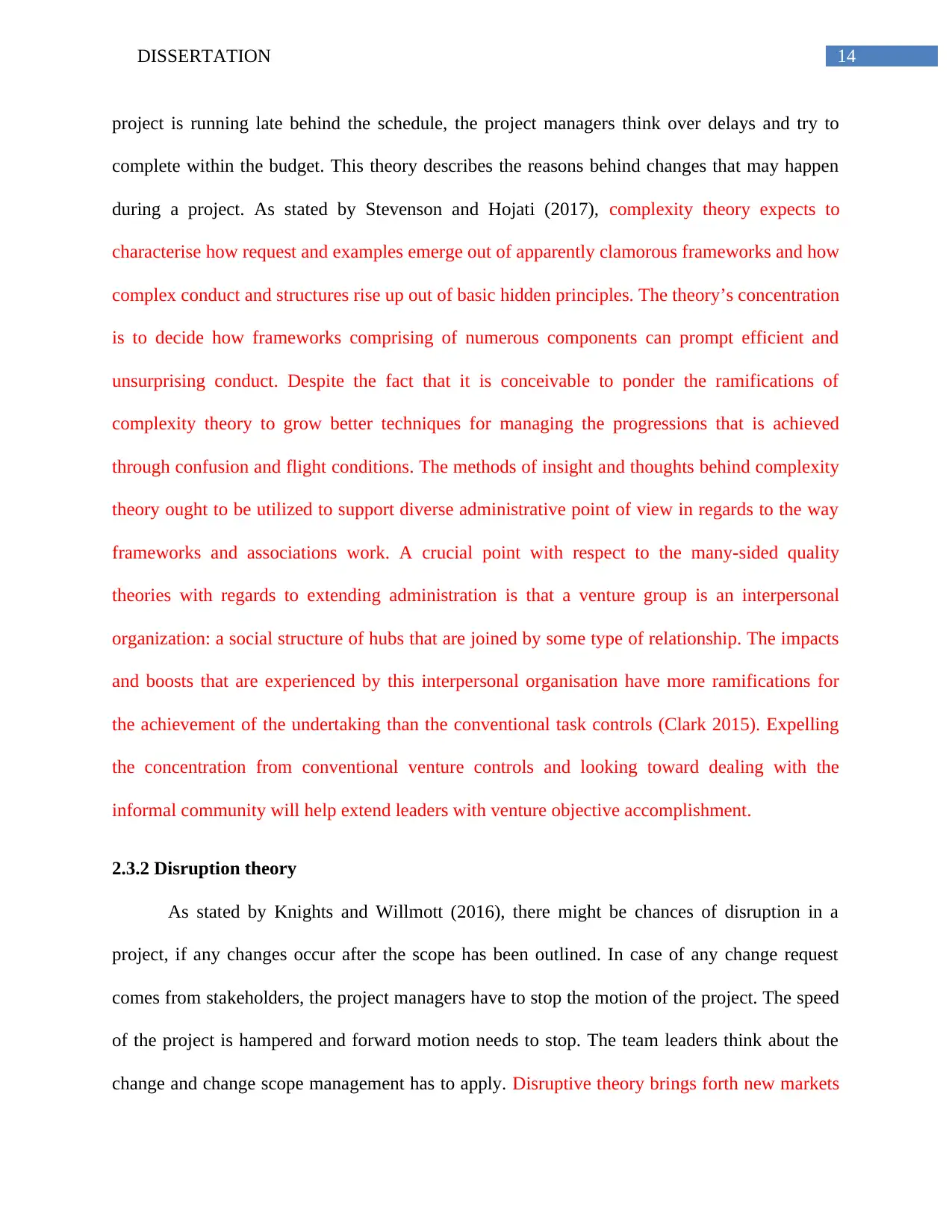
14DISSERTATION
project is running late behind the schedule, the project managers think over delays and try to
complete within the budget. This theory describes the reasons behind changes that may happen
during a project. As stated by Stevenson and Hojati (2017), complexity theory expects to
characterise how request and examples emerge out of apparently clamorous frameworks and how
complex conduct and structures rise up out of basic hidden principles. The theory’s concentration
is to decide how frameworks comprising of numerous components can prompt efficient and
unsurprising conduct. Despite the fact that it is conceivable to ponder the ramifications of
complexity theory to grow better techniques for managing the progressions that is achieved
through confusion and flight conditions. The methods of insight and thoughts behind complexity
theory ought to be utilized to support diverse administrative point of view in regards to the way
frameworks and associations work. A crucial point with respect to the many-sided quality
theories with regards to extending administration is that a venture group is an interpersonal
organization: a social structure of hubs that are joined by some type of relationship. The impacts
and boosts that are experienced by this interpersonal organisation have more ramifications for
the achievement of the undertaking than the conventional task controls (Clark 2015). Expelling
the concentration from conventional venture controls and looking toward dealing with the
informal community will help extend leaders with venture objective accomplishment.
2.3.2 Disruption theory
As stated by Knights and Willmott (2016), there might be chances of disruption in a
project, if any changes occur after the scope has been outlined. In case of any change request
comes from stakeholders, the project managers have to stop the motion of the project. The speed
of the project is hampered and forward motion needs to stop. The team leaders think about the
change and change scope management has to apply. Disruptive theory brings forth new markets
project is running late behind the schedule, the project managers think over delays and try to
complete within the budget. This theory describes the reasons behind changes that may happen
during a project. As stated by Stevenson and Hojati (2017), complexity theory expects to
characterise how request and examples emerge out of apparently clamorous frameworks and how
complex conduct and structures rise up out of basic hidden principles. The theory’s concentration
is to decide how frameworks comprising of numerous components can prompt efficient and
unsurprising conduct. Despite the fact that it is conceivable to ponder the ramifications of
complexity theory to grow better techniques for managing the progressions that is achieved
through confusion and flight conditions. The methods of insight and thoughts behind complexity
theory ought to be utilized to support diverse administrative point of view in regards to the way
frameworks and associations work. A crucial point with respect to the many-sided quality
theories with regards to extending administration is that a venture group is an interpersonal
organization: a social structure of hubs that are joined by some type of relationship. The impacts
and boosts that are experienced by this interpersonal organisation have more ramifications for
the achievement of the undertaking than the conventional task controls (Clark 2015). Expelling
the concentration from conventional venture controls and looking toward dealing with the
informal community will help extend leaders with venture objective accomplishment.
2.3.2 Disruption theory
As stated by Knights and Willmott (2016), there might be chances of disruption in a
project, if any changes occur after the scope has been outlined. In case of any change request
comes from stakeholders, the project managers have to stop the motion of the project. The speed
of the project is hampered and forward motion needs to stop. The team leaders think about the
change and change scope management has to apply. Disruptive theory brings forth new markets
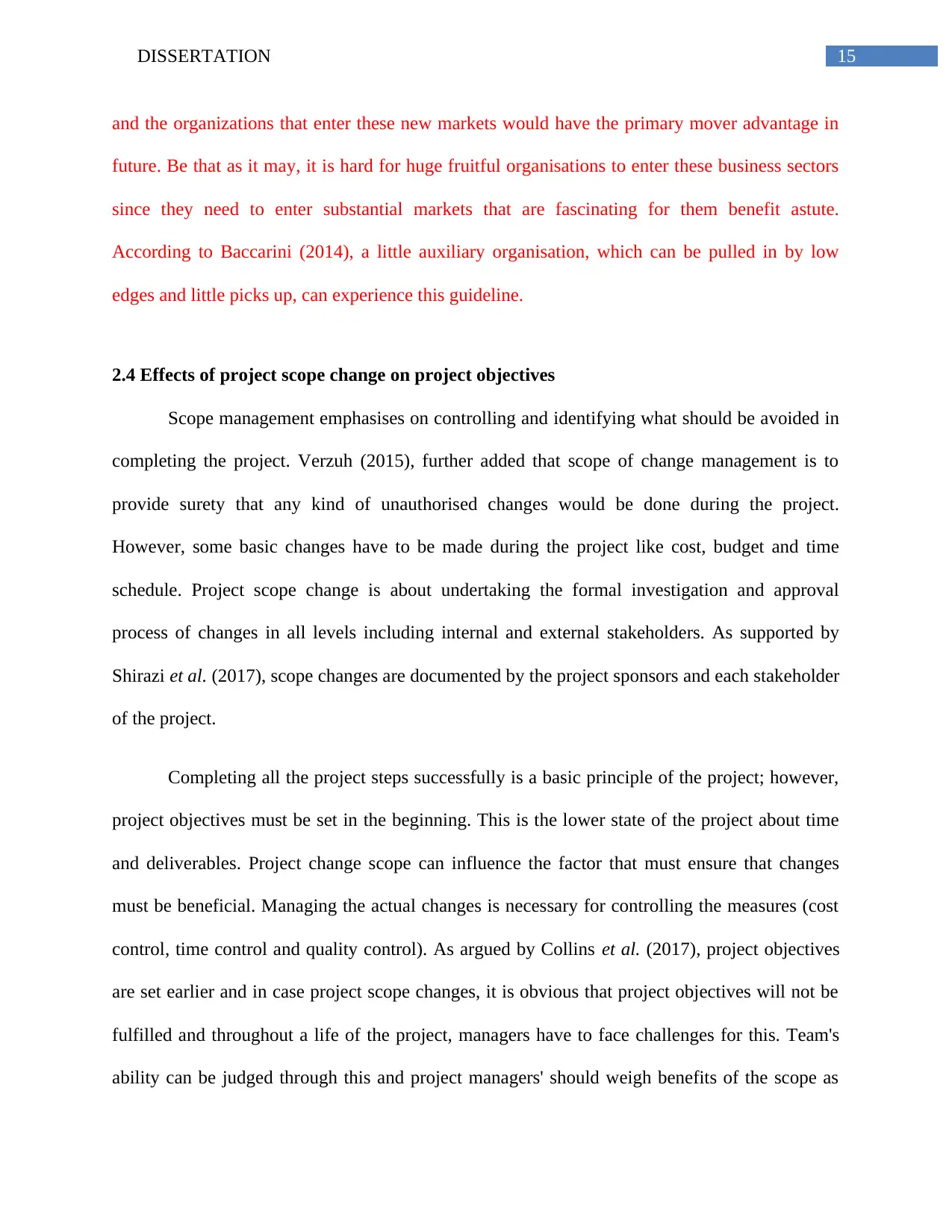
15DISSERTATION
and the organizations that enter these new markets would have the primary mover advantage in
future. Be that as it may, it is hard for huge fruitful organisations to enter these business sectors
since they need to enter substantial markets that are fascinating for them benefit astute.
According to Baccarini (2014), a little auxiliary organisation, which can be pulled in by low
edges and little picks up, can experience this guideline.
2.4 Effects of project scope change on project objectives
Scope management emphasises on controlling and identifying what should be avoided in
completing the project. Verzuh (2015), further added that scope of change management is to
provide surety that any kind of unauthorised changes would be done during the project.
However, some basic changes have to be made during the project like cost, budget and time
schedule. Project scope change is about undertaking the formal investigation and approval
process of changes in all levels including internal and external stakeholders. As supported by
Shirazi et al. (2017), scope changes are documented by the project sponsors and each stakeholder
of the project.
Completing all the project steps successfully is a basic principle of the project; however,
project objectives must be set in the beginning. This is the lower state of the project about time
and deliverables. Project change scope can influence the factor that must ensure that changes
must be beneficial. Managing the actual changes is necessary for controlling the measures (cost
control, time control and quality control). As argued by Collins et al. (2017), project objectives
are set earlier and in case project scope changes, it is obvious that project objectives will not be
fulfilled and throughout a life of the project, managers have to face challenges for this. Team's
ability can be judged through this and project managers' should weigh benefits of the scope as
and the organizations that enter these new markets would have the primary mover advantage in
future. Be that as it may, it is hard for huge fruitful organisations to enter these business sectors
since they need to enter substantial markets that are fascinating for them benefit astute.
According to Baccarini (2014), a little auxiliary organisation, which can be pulled in by low
edges and little picks up, can experience this guideline.
2.4 Effects of project scope change on project objectives
Scope management emphasises on controlling and identifying what should be avoided in
completing the project. Verzuh (2015), further added that scope of change management is to
provide surety that any kind of unauthorised changes would be done during the project.
However, some basic changes have to be made during the project like cost, budget and time
schedule. Project scope change is about undertaking the formal investigation and approval
process of changes in all levels including internal and external stakeholders. As supported by
Shirazi et al. (2017), scope changes are documented by the project sponsors and each stakeholder
of the project.
Completing all the project steps successfully is a basic principle of the project; however,
project objectives must be set in the beginning. This is the lower state of the project about time
and deliverables. Project change scope can influence the factor that must ensure that changes
must be beneficial. Managing the actual changes is necessary for controlling the measures (cost
control, time control and quality control). As argued by Collins et al. (2017), project objectives
are set earlier and in case project scope changes, it is obvious that project objectives will not be
fulfilled and throughout a life of the project, managers have to face challenges for this. Team's
ability can be judged through this and project managers' should weigh benefits of the scope as
Secure Best Marks with AI Grader
Need help grading? Try our AI Grader for instant feedback on your assignments.
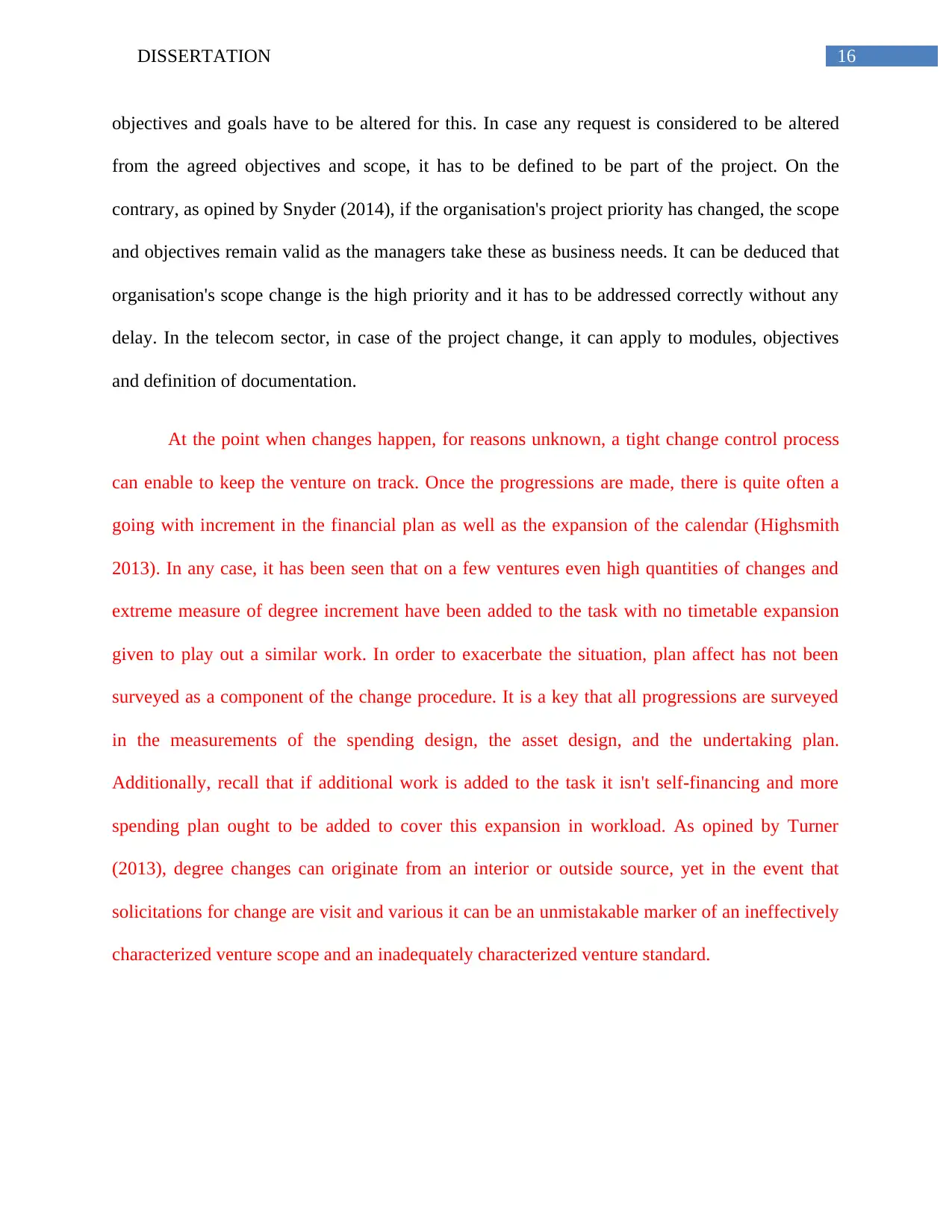
16DISSERTATION
objectives and goals have to be altered for this. In case any request is considered to be altered
from the agreed objectives and scope, it has to be defined to be part of the project. On the
contrary, as opined by Snyder (2014), if the organisation's project priority has changed, the scope
and objectives remain valid as the managers take these as business needs. It can be deduced that
organisation's scope change is the high priority and it has to be addressed correctly without any
delay. In the telecom sector, in case of the project change, it can apply to modules, objectives
and definition of documentation.
At the point when changes happen, for reasons unknown, a tight change control process
can enable to keep the venture on track. Once the progressions are made, there is quite often a
going with increment in the financial plan as well as the expansion of the calendar (Highsmith
2013). In any case, it has been seen that on a few ventures even high quantities of changes and
extreme measure of degree increment have been added to the task with no timetable expansion
given to play out a similar work. In order to exacerbate the situation, plan affect has not been
surveyed as a component of the change procedure. It is a key that all progressions are surveyed
in the measurements of the spending design, the asset design, and the undertaking plan.
Additionally, recall that if additional work is added to the task it isn't self-financing and more
spending plan ought to be added to cover this expansion in workload. As opined by Turner
(2013), degree changes can originate from an interior or outside source, yet in the event that
solicitations for change are visit and various it can be an unmistakable marker of an ineffectively
characterized venture scope and an inadequately characterized venture standard.
objectives and goals have to be altered for this. In case any request is considered to be altered
from the agreed objectives and scope, it has to be defined to be part of the project. On the
contrary, as opined by Snyder (2014), if the organisation's project priority has changed, the scope
and objectives remain valid as the managers take these as business needs. It can be deduced that
organisation's scope change is the high priority and it has to be addressed correctly without any
delay. In the telecom sector, in case of the project change, it can apply to modules, objectives
and definition of documentation.
At the point when changes happen, for reasons unknown, a tight change control process
can enable to keep the venture on track. Once the progressions are made, there is quite often a
going with increment in the financial plan as well as the expansion of the calendar (Highsmith
2013). In any case, it has been seen that on a few ventures even high quantities of changes and
extreme measure of degree increment have been added to the task with no timetable expansion
given to play out a similar work. In order to exacerbate the situation, plan affect has not been
surveyed as a component of the change procedure. It is a key that all progressions are surveyed
in the measurements of the spending design, the asset design, and the undertaking plan.
Additionally, recall that if additional work is added to the task it isn't self-financing and more
spending plan ought to be added to cover this expansion in workload. As opined by Turner
(2013), degree changes can originate from an interior or outside source, yet in the event that
solicitations for change are visit and various it can be an unmistakable marker of an ineffectively
characterized venture scope and an inadequately characterized venture standard.
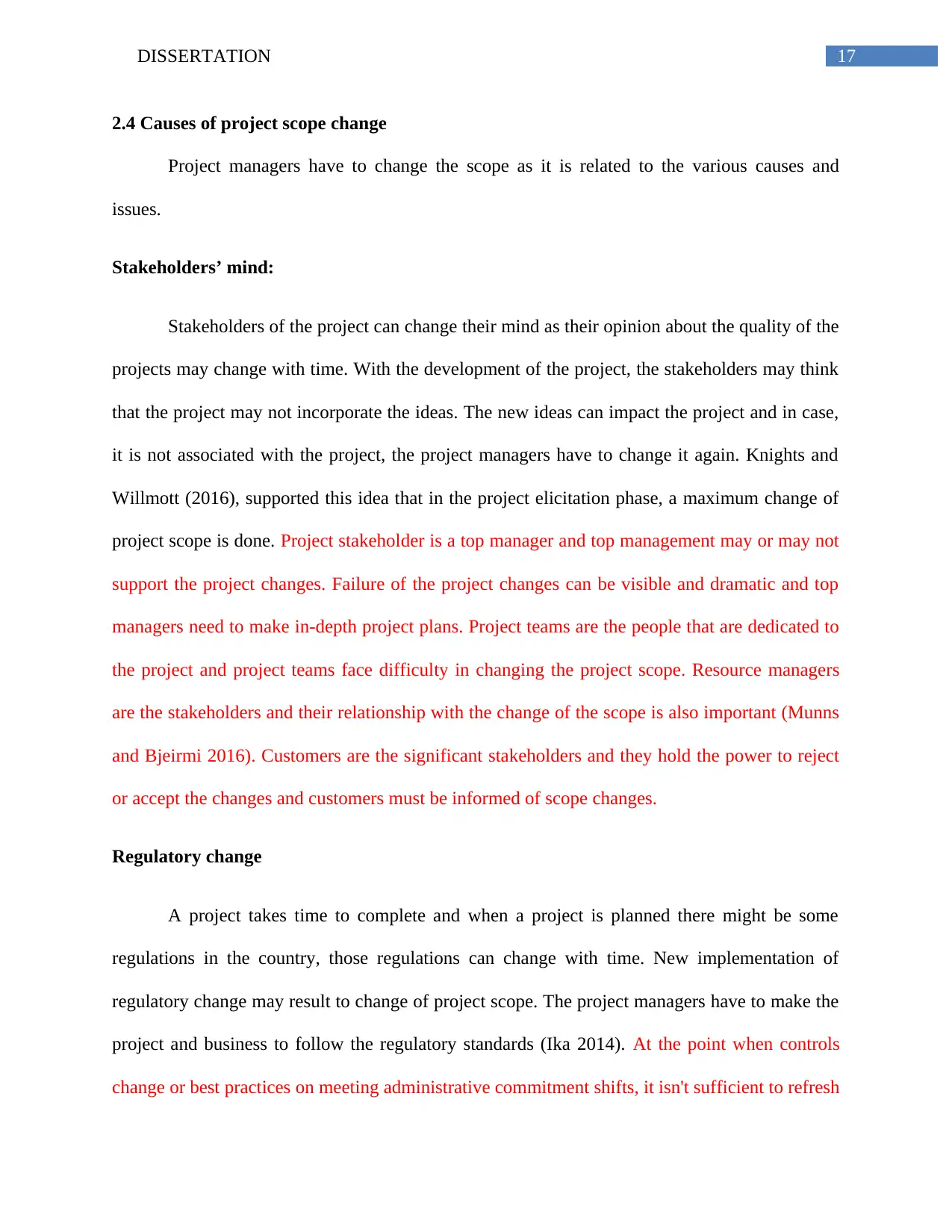
17DISSERTATION
2.4 Causes of project scope change
Project managers have to change the scope as it is related to the various causes and
issues.
Stakeholders’ mind:
Stakeholders of the project can change their mind as their opinion about the quality of the
projects may change with time. With the development of the project, the stakeholders may think
that the project may not incorporate the ideas. The new ideas can impact the project and in case,
it is not associated with the project, the project managers have to change it again. Knights and
Willmott (2016), supported this idea that in the project elicitation phase, a maximum change of
project scope is done. Project stakeholder is a top manager and top management may or may not
support the project changes. Failure of the project changes can be visible and dramatic and top
managers need to make in-depth project plans. Project teams are the people that are dedicated to
the project and project teams face difficulty in changing the project scope. Resource managers
are the stakeholders and their relationship with the change of the scope is also important (Munns
and Bjeirmi 2016). Customers are the significant stakeholders and they hold the power to reject
or accept the changes and customers must be informed of scope changes.
Regulatory change
A project takes time to complete and when a project is planned there might be some
regulations in the country, those regulations can change with time. New implementation of
regulatory change may result to change of project scope. The project managers have to make the
project and business to follow the regulatory standards (Ika 2014). At the point when controls
change or best practices on meeting administrative commitment shifts, it isn't sufficient to refresh
2.4 Causes of project scope change
Project managers have to change the scope as it is related to the various causes and
issues.
Stakeholders’ mind:
Stakeholders of the project can change their mind as their opinion about the quality of the
projects may change with time. With the development of the project, the stakeholders may think
that the project may not incorporate the ideas. The new ideas can impact the project and in case,
it is not associated with the project, the project managers have to change it again. Knights and
Willmott (2016), supported this idea that in the project elicitation phase, a maximum change of
project scope is done. Project stakeholder is a top manager and top management may or may not
support the project changes. Failure of the project changes can be visible and dramatic and top
managers need to make in-depth project plans. Project teams are the people that are dedicated to
the project and project teams face difficulty in changing the project scope. Resource managers
are the stakeholders and their relationship with the change of the scope is also important (Munns
and Bjeirmi 2016). Customers are the significant stakeholders and they hold the power to reject
or accept the changes and customers must be informed of scope changes.
Regulatory change
A project takes time to complete and when a project is planned there might be some
regulations in the country, those regulations can change with time. New implementation of
regulatory change may result to change of project scope. The project managers have to make the
project and business to follow the regulatory standards (Ika 2014). At the point when controls
change or best practices on meeting administrative commitment shifts, it isn't sufficient to refresh
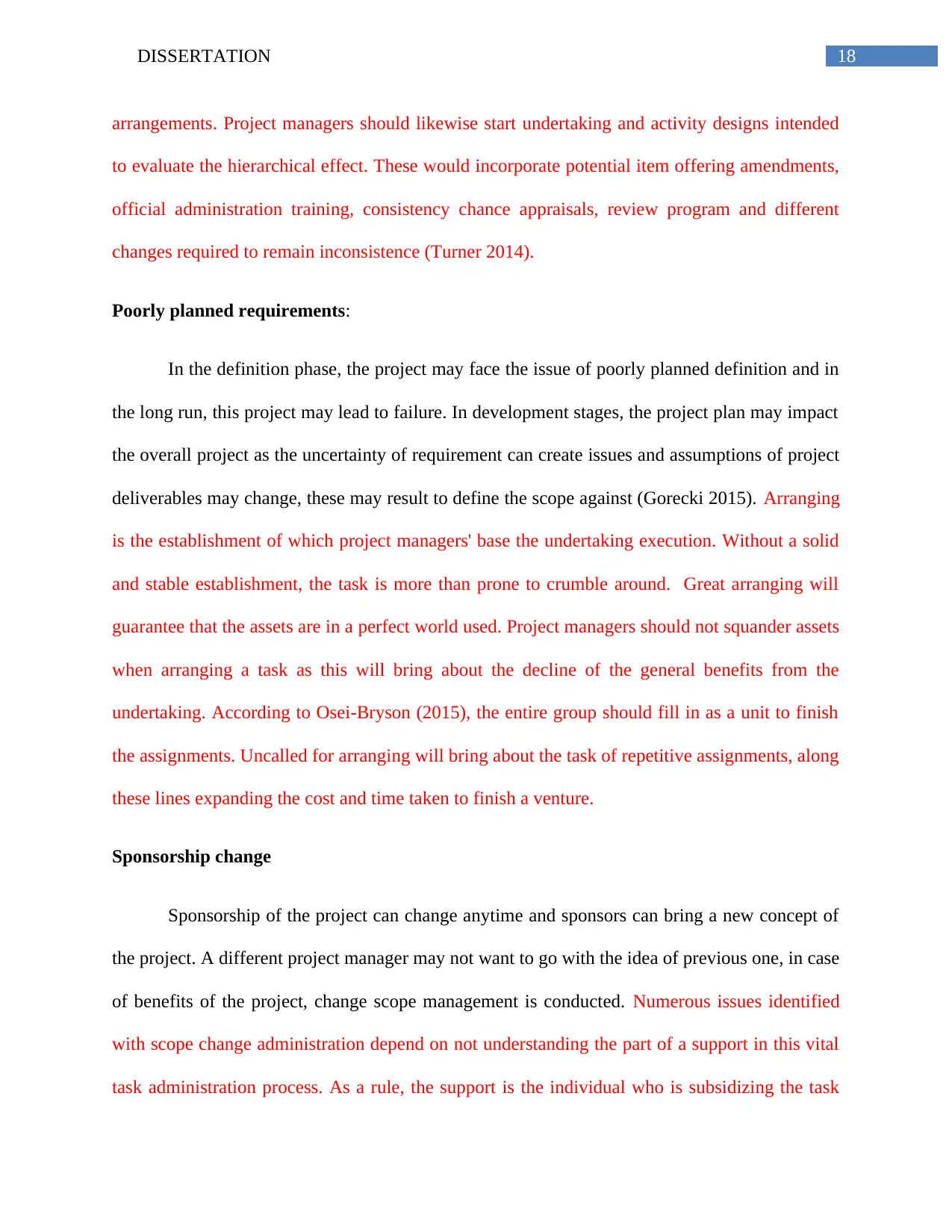
18DISSERTATION
arrangements. Project managers should likewise start undertaking and activity designs intended
to evaluate the hierarchical effect. These would incorporate potential item offering amendments,
official administration training, consistency chance appraisals, review program and different
changes required to remain inconsistence (Turner 2014).
Poorly planned requirements:
In the definition phase, the project may face the issue of poorly planned definition and in
the long run, this project may lead to failure. In development stages, the project plan may impact
the overall project as the uncertainty of requirement can create issues and assumptions of project
deliverables may change, these may result to define the scope against (Gorecki 2015). Arranging
is the establishment of which project managers' base the undertaking execution. Without a solid
and stable establishment, the task is more than prone to crumble around. Great arranging will
guarantee that the assets are in a perfect world used. Project managers should not squander assets
when arranging a task as this will bring about the decline of the general benefits from the
undertaking. According to Osei-Bryson (2015), the entire group should fill in as a unit to finish
the assignments. Uncalled for arranging will bring about the task of repetitive assignments, along
these lines expanding the cost and time taken to finish a venture.
Sponsorship change
Sponsorship of the project can change anytime and sponsors can bring a new concept of
the project. A different project manager may not want to go with the idea of previous one, in case
of benefits of the project, change scope management is conducted. Numerous issues identified
with scope change administration depend on not understanding the part of a support in this vital
task administration process. As a rule, the support is the individual who is subsidizing the task
arrangements. Project managers should likewise start undertaking and activity designs intended
to evaluate the hierarchical effect. These would incorporate potential item offering amendments,
official administration training, consistency chance appraisals, review program and different
changes required to remain inconsistence (Turner 2014).
Poorly planned requirements:
In the definition phase, the project may face the issue of poorly planned definition and in
the long run, this project may lead to failure. In development stages, the project plan may impact
the overall project as the uncertainty of requirement can create issues and assumptions of project
deliverables may change, these may result to define the scope against (Gorecki 2015). Arranging
is the establishment of which project managers' base the undertaking execution. Without a solid
and stable establishment, the task is more than prone to crumble around. Great arranging will
guarantee that the assets are in a perfect world used. Project managers should not squander assets
when arranging a task as this will bring about the decline of the general benefits from the
undertaking. According to Osei-Bryson (2015), the entire group should fill in as a unit to finish
the assignments. Uncalled for arranging will bring about the task of repetitive assignments, along
these lines expanding the cost and time taken to finish a venture.
Sponsorship change
Sponsorship of the project can change anytime and sponsors can bring a new concept of
the project. A different project manager may not want to go with the idea of previous one, in case
of benefits of the project, change scope management is conducted. Numerous issues identified
with scope change administration depend on not understanding the part of a support in this vital
task administration process. As a rule, the support is the individual who is subsidizing the task
Paraphrase This Document
Need a fresh take? Get an instant paraphrase of this document with our AI Paraphraser
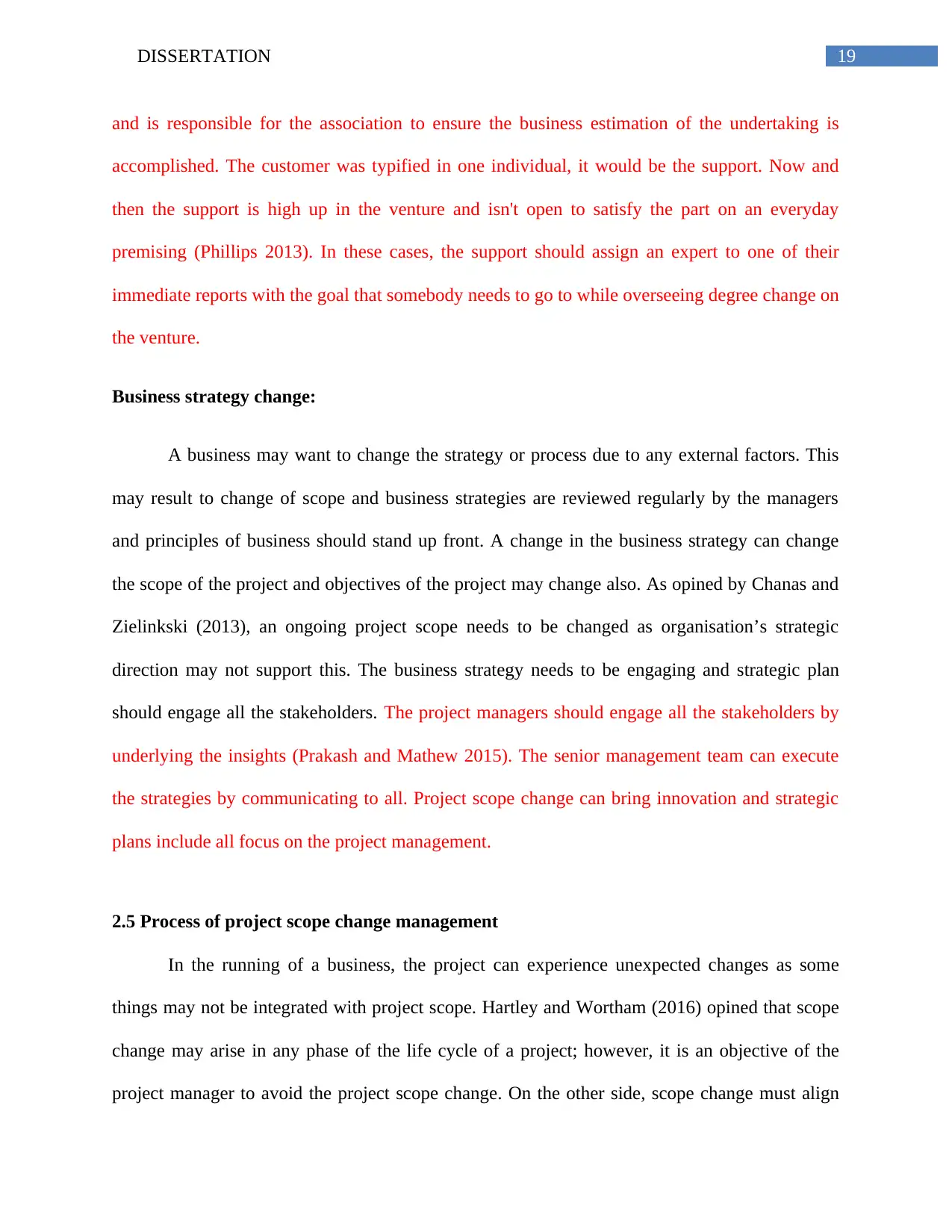
19DISSERTATION
and is responsible for the association to ensure the business estimation of the undertaking is
accomplished. The customer was typified in one individual, it would be the support. Now and
then the support is high up in the venture and isn't open to satisfy the part on an everyday
premising (Phillips 2013). In these cases, the support should assign an expert to one of their
immediate reports with the goal that somebody needs to go to while overseeing degree change on
the venture.
Business strategy change:
A business may want to change the strategy or process due to any external factors. This
may result to change of scope and business strategies are reviewed regularly by the managers
and principles of business should stand up front. A change in the business strategy can change
the scope of the project and objectives of the project may change also. As opined by Chanas and
Zielinkski (2013), an ongoing project scope needs to be changed as organisation’s strategic
direction may not support this. The business strategy needs to be engaging and strategic plan
should engage all the stakeholders. The project managers should engage all the stakeholders by
underlying the insights (Prakash and Mathew 2015). The senior management team can execute
the strategies by communicating to all. Project scope change can bring innovation and strategic
plans include all focus on the project management.
2.5 Process of project scope change management
In the running of a business, the project can experience unexpected changes as some
things may not be integrated with project scope. Hartley and Wortham (2016) opined that scope
change may arise in any phase of the life cycle of a project; however, it is an objective of the
project manager to avoid the project scope change. On the other side, scope change must align
and is responsible for the association to ensure the business estimation of the undertaking is
accomplished. The customer was typified in one individual, it would be the support. Now and
then the support is high up in the venture and isn't open to satisfy the part on an everyday
premising (Phillips 2013). In these cases, the support should assign an expert to one of their
immediate reports with the goal that somebody needs to go to while overseeing degree change on
the venture.
Business strategy change:
A business may want to change the strategy or process due to any external factors. This
may result to change of scope and business strategies are reviewed regularly by the managers
and principles of business should stand up front. A change in the business strategy can change
the scope of the project and objectives of the project may change also. As opined by Chanas and
Zielinkski (2013), an ongoing project scope needs to be changed as organisation’s strategic
direction may not support this. The business strategy needs to be engaging and strategic plan
should engage all the stakeholders. The project managers should engage all the stakeholders by
underlying the insights (Prakash and Mathew 2015). The senior management team can execute
the strategies by communicating to all. Project scope change can bring innovation and strategic
plans include all focus on the project management.
2.5 Process of project scope change management
In the running of a business, the project can experience unexpected changes as some
things may not be integrated with project scope. Hartley and Wortham (2016) opined that scope
change may arise in any phase of the life cycle of a project; however, it is an objective of the
project manager to avoid the project scope change. On the other side, scope change must align
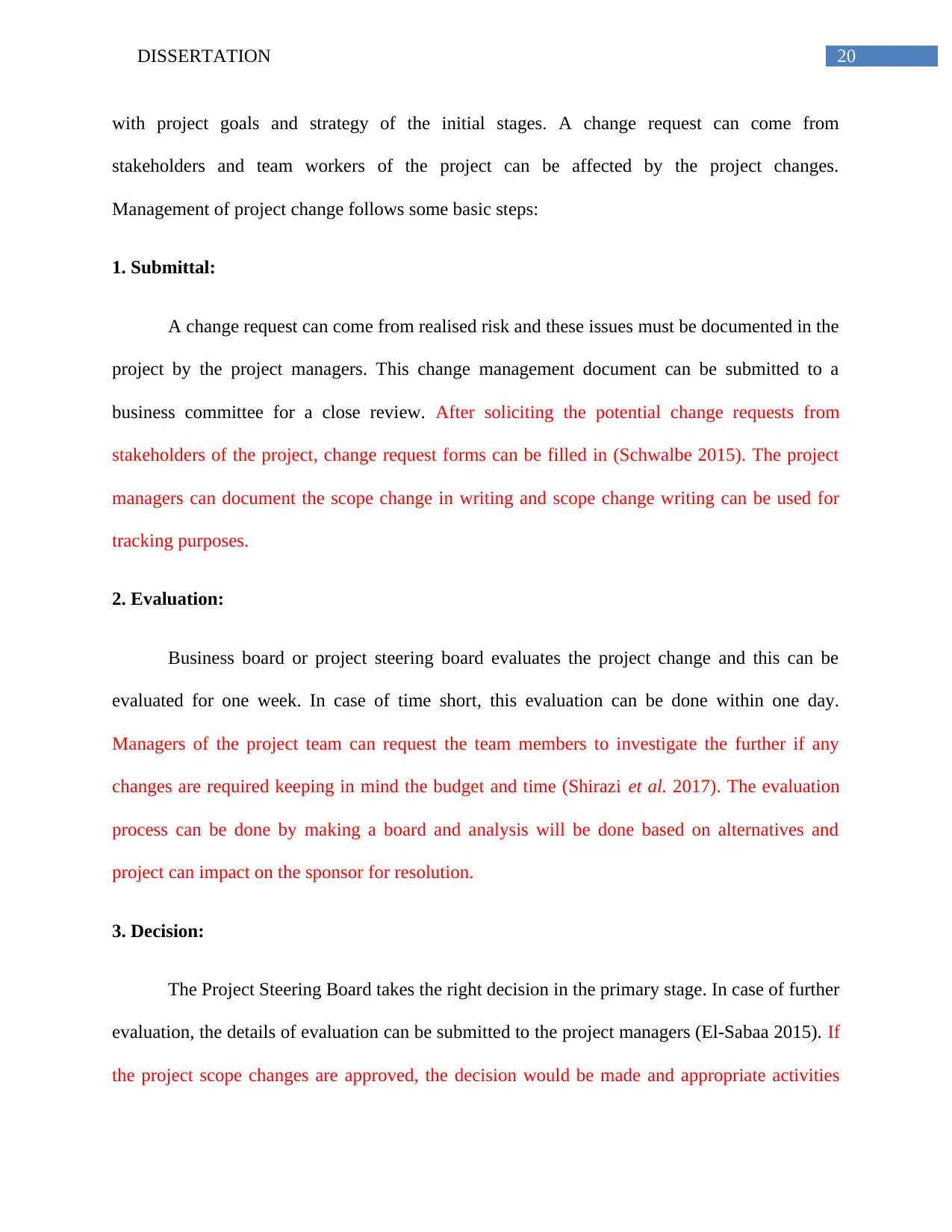
20DISSERTATION
with project goals and strategy of the initial stages. A change request can come from
stakeholders and team workers of the project can be affected by the project changes.
Management of project change follows some basic steps:
1. Submittal:
A change request can come from realised risk and these issues must be documented in the
project by the project managers. This change management document can be submitted to a
business committee for a close review. After soliciting the potential change requests from
stakeholders of the project, change request forms can be filled in (Schwalbe 2015). The project
managers can document the scope change in writing and scope change writing can be used for
tracking purposes.
2. Evaluation:
Business board or project steering board evaluates the project change and this can be
evaluated for one week. In case of time short, this evaluation can be done within one day.
Managers of the project team can request the team members to investigate the further if any
changes are required keeping in mind the budget and time (Shirazi et al. 2017). The evaluation
process can be done by making a board and analysis will be done based on alternatives and
project can impact on the sponsor for resolution.
3. Decision:
The Project Steering Board takes the right decision in the primary stage. In case of further
evaluation, the details of evaluation can be submitted to the project managers (El-Sabaa 2015). If
the project scope changes are approved, the decision would be made and appropriate activities
with project goals and strategy of the initial stages. A change request can come from
stakeholders and team workers of the project can be affected by the project changes.
Management of project change follows some basic steps:
1. Submittal:
A change request can come from realised risk and these issues must be documented in the
project by the project managers. This change management document can be submitted to a
business committee for a close review. After soliciting the potential change requests from
stakeholders of the project, change request forms can be filled in (Schwalbe 2015). The project
managers can document the scope change in writing and scope change writing can be used for
tracking purposes.
2. Evaluation:
Business board or project steering board evaluates the project change and this can be
evaluated for one week. In case of time short, this evaluation can be done within one day.
Managers of the project team can request the team members to investigate the further if any
changes are required keeping in mind the budget and time (Shirazi et al. 2017). The evaluation
process can be done by making a board and analysis will be done based on alternatives and
project can impact on the sponsor for resolution.
3. Decision:
The Project Steering Board takes the right decision in the primary stage. In case of further
evaluation, the details of evaluation can be submitted to the project managers (El-Sabaa 2015). If
the project scope changes are approved, the decision would be made and appropriate activities
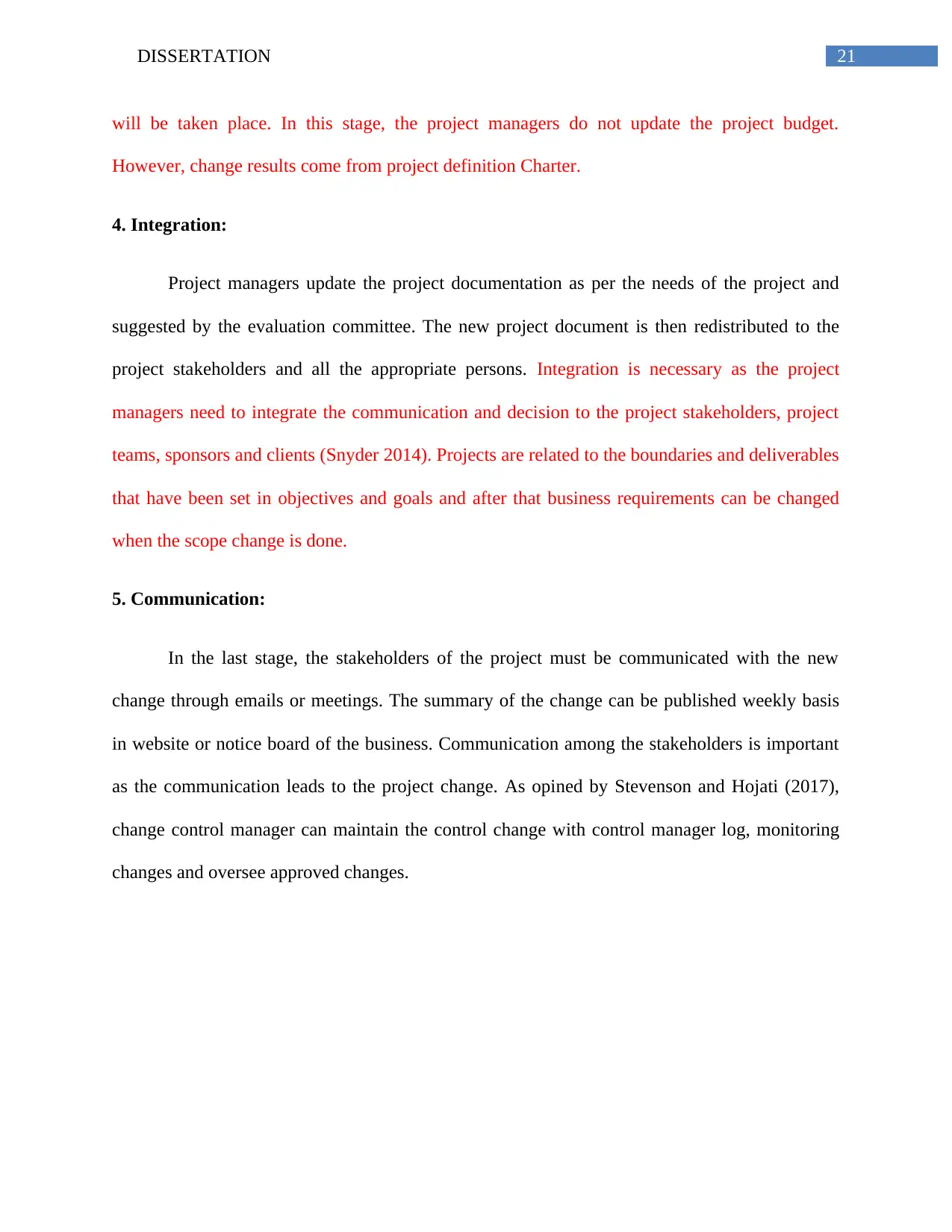
21DISSERTATION
will be taken place. In this stage, the project managers do not update the project budget.
However, change results come from project definition Charter.
4. Integration:
Project managers update the project documentation as per the needs of the project and
suggested by the evaluation committee. The new project document is then redistributed to the
project stakeholders and all the appropriate persons. Integration is necessary as the project
managers need to integrate the communication and decision to the project stakeholders, project
teams, sponsors and clients (Snyder 2014). Projects are related to the boundaries and deliverables
that have been set in objectives and goals and after that business requirements can be changed
when the scope change is done.
5. Communication:
In the last stage, the stakeholders of the project must be communicated with the new
change through emails or meetings. The summary of the change can be published weekly basis
in website or notice board of the business. Communication among the stakeholders is important
as the communication leads to the project change. As opined by Stevenson and Hojati (2017),
change control manager can maintain the control change with control manager log, monitoring
changes and oversee approved changes.
will be taken place. In this stage, the project managers do not update the project budget.
However, change results come from project definition Charter.
4. Integration:
Project managers update the project documentation as per the needs of the project and
suggested by the evaluation committee. The new project document is then redistributed to the
project stakeholders and all the appropriate persons. Integration is necessary as the project
managers need to integrate the communication and decision to the project stakeholders, project
teams, sponsors and clients (Snyder 2014). Projects are related to the boundaries and deliverables
that have been set in objectives and goals and after that business requirements can be changed
when the scope change is done.
5. Communication:
In the last stage, the stakeholders of the project must be communicated with the new
change through emails or meetings. The summary of the change can be published weekly basis
in website or notice board of the business. Communication among the stakeholders is important
as the communication leads to the project change. As opined by Stevenson and Hojati (2017),
change control manager can maintain the control change with control manager log, monitoring
changes and oversee approved changes.
Secure Best Marks with AI Grader
Need help grading? Try our AI Grader for instant feedback on your assignments.
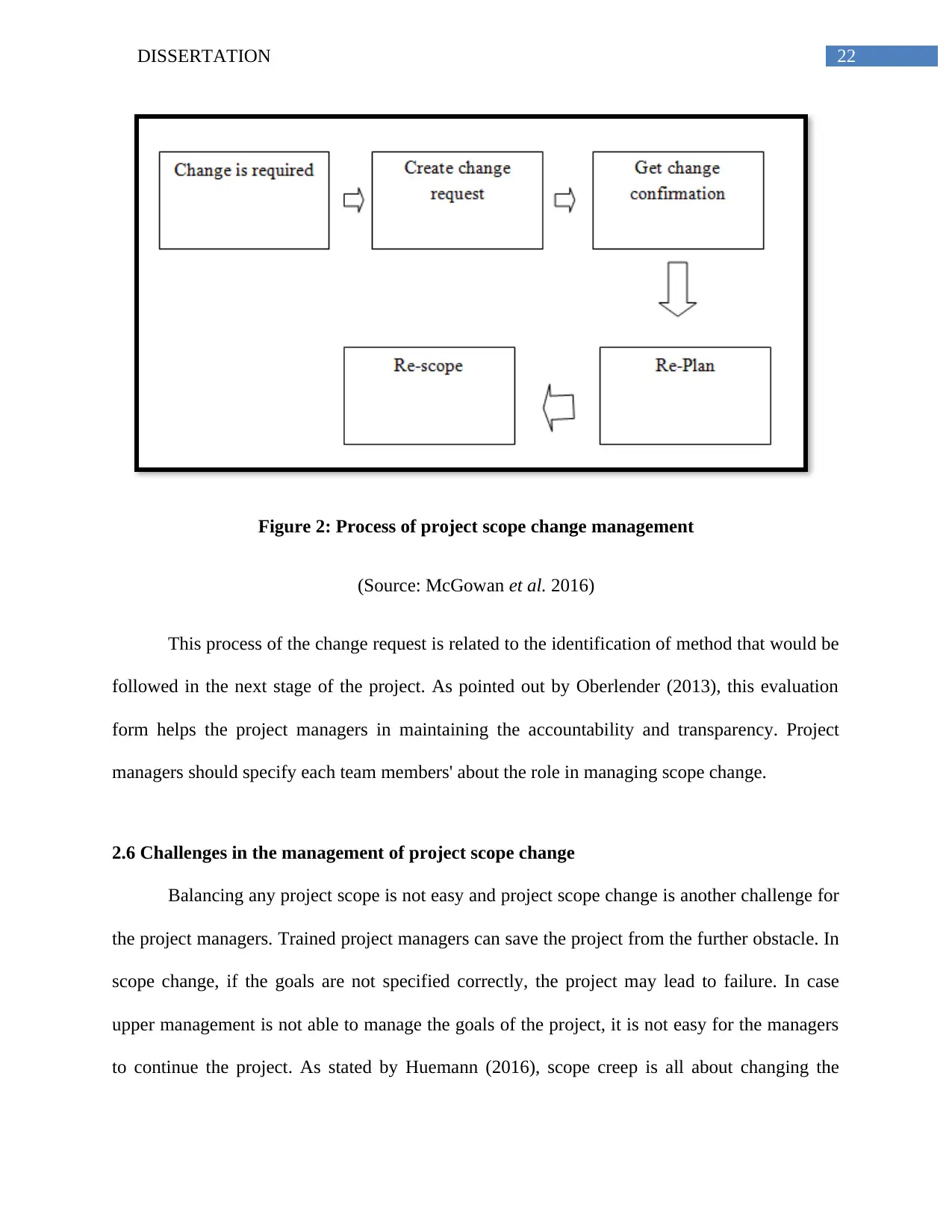
22DISSERTATION
Figure 2: Process of project scope change management
(Source: McGowan et al. 2016)
This process of the change request is related to the identification of method that would be
followed in the next stage of the project. As pointed out by Oberlender (2013), this evaluation
form helps the project managers in maintaining the accountability and transparency. Project
managers should specify each team members' about the role in managing scope change.
2.6 Challenges in the management of project scope change
Balancing any project scope is not easy and project scope change is another challenge for
the project managers. Trained project managers can save the project from the further obstacle. In
scope change, if the goals are not specified correctly, the project may lead to failure. In case
upper management is not able to manage the goals of the project, it is not easy for the managers
to continue the project. As stated by Huemann (2016), scope creep is all about changing the
Figure 2: Process of project scope change management
(Source: McGowan et al. 2016)
This process of the change request is related to the identification of method that would be
followed in the next stage of the project. As pointed out by Oberlender (2013), this evaluation
form helps the project managers in maintaining the accountability and transparency. Project
managers should specify each team members' about the role in managing scope change.
2.6 Challenges in the management of project scope change
Balancing any project scope is not easy and project scope change is another challenge for
the project managers. Trained project managers can save the project from the further obstacle. In
scope change, if the goals are not specified correctly, the project may lead to failure. In case
upper management is not able to manage the goals of the project, it is not easy for the managers
to continue the project. As stated by Huemann (2016), scope creep is all about changing the
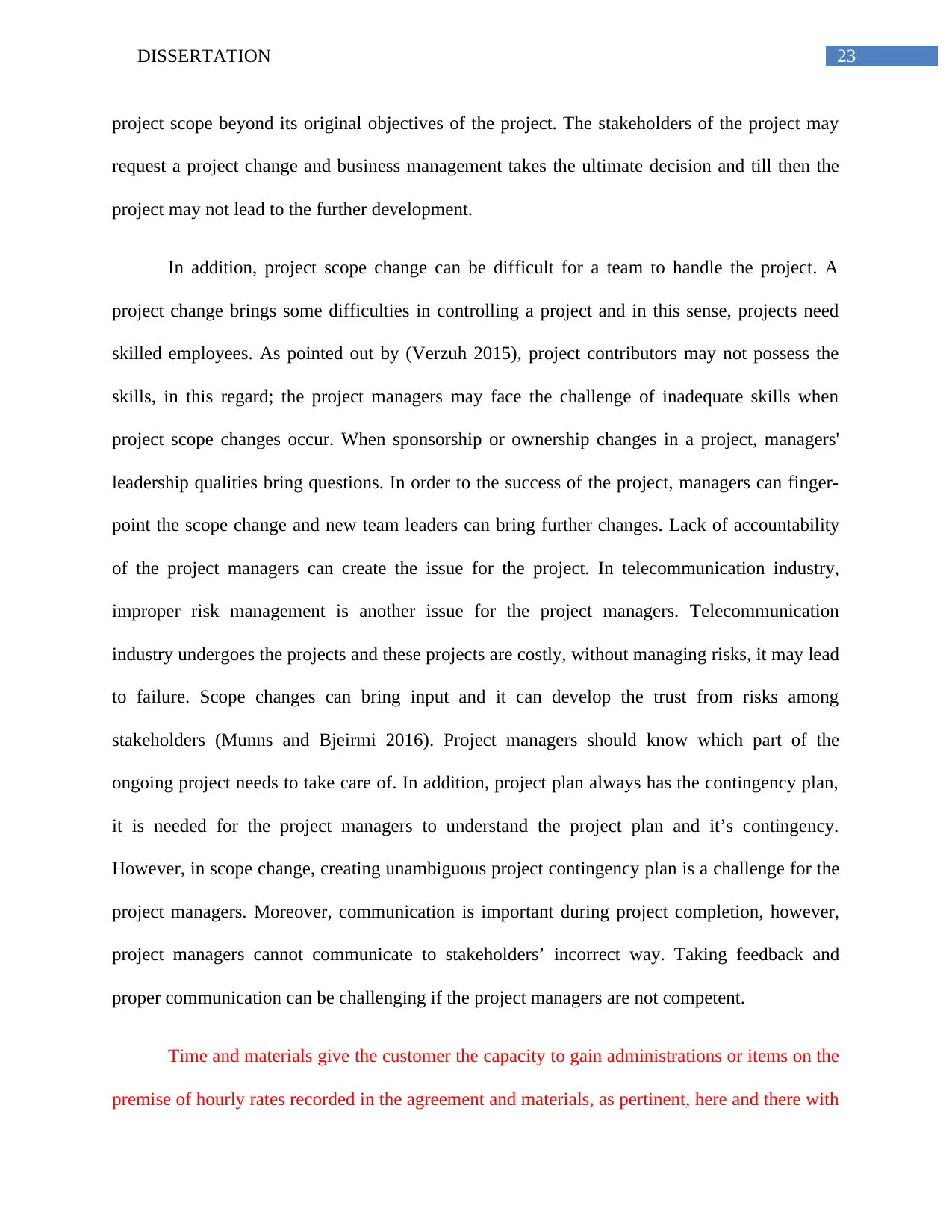
23DISSERTATION
project scope beyond its original objectives of the project. The stakeholders of the project may
request a project change and business management takes the ultimate decision and till then the
project may not lead to the further development.
In addition, project scope change can be difficult for a team to handle the project. A
project change brings some difficulties in controlling a project and in this sense, projects need
skilled employees. As pointed out by (Verzuh 2015), project contributors may not possess the
skills, in this regard; the project managers may face the challenge of inadequate skills when
project scope changes occur. When sponsorship or ownership changes in a project, managers'
leadership qualities bring questions. In order to the success of the project, managers can finger-
point the scope change and new team leaders can bring further changes. Lack of accountability
of the project managers can create the issue for the project. In telecommunication industry,
improper risk management is another issue for the project managers. Telecommunication
industry undergoes the projects and these projects are costly, without managing risks, it may lead
to failure. Scope changes can bring input and it can develop the trust from risks among
stakeholders (Munns and Bjeirmi 2016). Project managers should know which part of the
ongoing project needs to take care of. In addition, project plan always has the contingency plan,
it is needed for the project managers to understand the project plan and it’s contingency.
However, in scope change, creating unambiguous project contingency plan is a challenge for the
project managers. Moreover, communication is important during project completion, however,
project managers cannot communicate to stakeholders’ incorrect way. Taking feedback and
proper communication can be challenging if the project managers are not competent.
Time and materials give the customer the capacity to gain administrations or items on the
premise of hourly rates recorded in the agreement and materials, as pertinent, here and there with
project scope beyond its original objectives of the project. The stakeholders of the project may
request a project change and business management takes the ultimate decision and till then the
project may not lead to the further development.
In addition, project scope change can be difficult for a team to handle the project. A
project change brings some difficulties in controlling a project and in this sense, projects need
skilled employees. As pointed out by (Verzuh 2015), project contributors may not possess the
skills, in this regard; the project managers may face the challenge of inadequate skills when
project scope changes occur. When sponsorship or ownership changes in a project, managers'
leadership qualities bring questions. In order to the success of the project, managers can finger-
point the scope change and new team leaders can bring further changes. Lack of accountability
of the project managers can create the issue for the project. In telecommunication industry,
improper risk management is another issue for the project managers. Telecommunication
industry undergoes the projects and these projects are costly, without managing risks, it may lead
to failure. Scope changes can bring input and it can develop the trust from risks among
stakeholders (Munns and Bjeirmi 2016). Project managers should know which part of the
ongoing project needs to take care of. In addition, project plan always has the contingency plan,
it is needed for the project managers to understand the project plan and it’s contingency.
However, in scope change, creating unambiguous project contingency plan is a challenge for the
project managers. Moreover, communication is important during project completion, however,
project managers cannot communicate to stakeholders’ incorrect way. Taking feedback and
proper communication can be challenging if the project managers are not competent.
Time and materials give the customer the capacity to gain administrations or items on the
premise of hourly rates recorded in the agreement and materials, as pertinent, here and there with
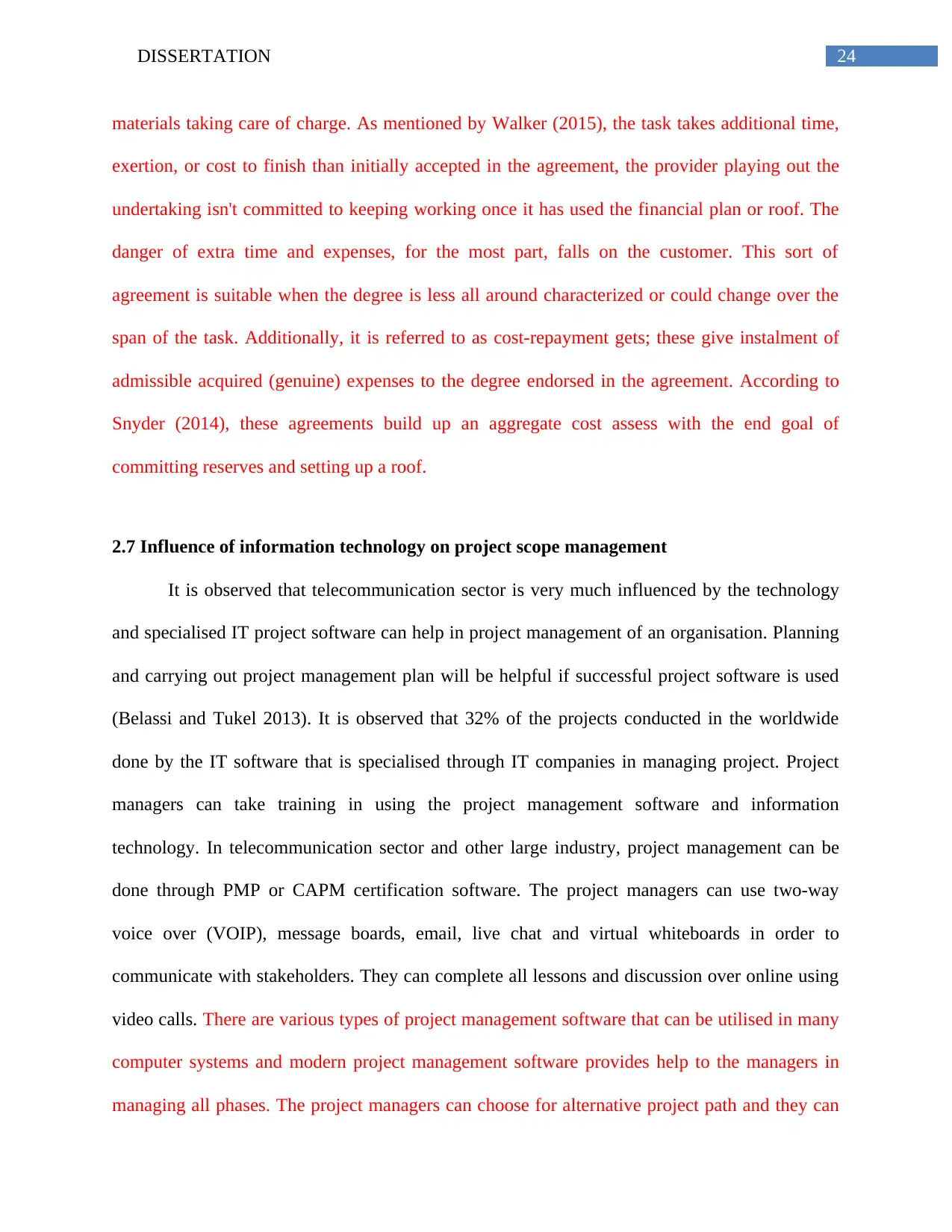
24DISSERTATION
materials taking care of charge. As mentioned by Walker (2015), the task takes additional time,
exertion, or cost to finish than initially accepted in the agreement, the provider playing out the
undertaking isn't committed to keeping working once it has used the financial plan or roof. The
danger of extra time and expenses, for the most part, falls on the customer. This sort of
agreement is suitable when the degree is less all around characterized or could change over the
span of the task. Additionally, it is referred to as cost-repayment gets; these give instalment of
admissible acquired (genuine) expenses to the degree endorsed in the agreement. According to
Snyder (2014), these agreements build up an aggregate cost assess with the end goal of
committing reserves and setting up a roof.
2.7 Influence of information technology on project scope management
It is observed that telecommunication sector is very much influenced by the technology
and specialised IT project software can help in project management of an organisation. Planning
and carrying out project management plan will be helpful if successful project software is used
(Belassi and Tukel 2013). It is observed that 32% of the projects conducted in the worldwide
done by the IT software that is specialised through IT companies in managing project. Project
managers can take training in using the project management software and information
technology. In telecommunication sector and other large industry, project management can be
done through PMP or CAPM certification software. The project managers can use two-way
voice over (VOIP), message boards, email, live chat and virtual whiteboards in order to
communicate with stakeholders. They can complete all lessons and discussion over online using
video calls. There are various types of project management software that can be utilised in many
computer systems and modern project management software provides help to the managers in
managing all phases. The project managers can choose for alternative project path and they can
materials taking care of charge. As mentioned by Walker (2015), the task takes additional time,
exertion, or cost to finish than initially accepted in the agreement, the provider playing out the
undertaking isn't committed to keeping working once it has used the financial plan or roof. The
danger of extra time and expenses, for the most part, falls on the customer. This sort of
agreement is suitable when the degree is less all around characterized or could change over the
span of the task. Additionally, it is referred to as cost-repayment gets; these give instalment of
admissible acquired (genuine) expenses to the degree endorsed in the agreement. According to
Snyder (2014), these agreements build up an aggregate cost assess with the end goal of
committing reserves and setting up a roof.
2.7 Influence of information technology on project scope management
It is observed that telecommunication sector is very much influenced by the technology
and specialised IT project software can help in project management of an organisation. Planning
and carrying out project management plan will be helpful if successful project software is used
(Belassi and Tukel 2013). It is observed that 32% of the projects conducted in the worldwide
done by the IT software that is specialised through IT companies in managing project. Project
managers can take training in using the project management software and information
technology. In telecommunication sector and other large industry, project management can be
done through PMP or CAPM certification software. The project managers can use two-way
voice over (VOIP), message boards, email, live chat and virtual whiteboards in order to
communicate with stakeholders. They can complete all lessons and discussion over online using
video calls. There are various types of project management software that can be utilised in many
computer systems and modern project management software provides help to the managers in
managing all phases. The project managers can choose for alternative project path and they can
Paraphrase This Document
Need a fresh take? Get an instant paraphrase of this document with our AI Paraphraser
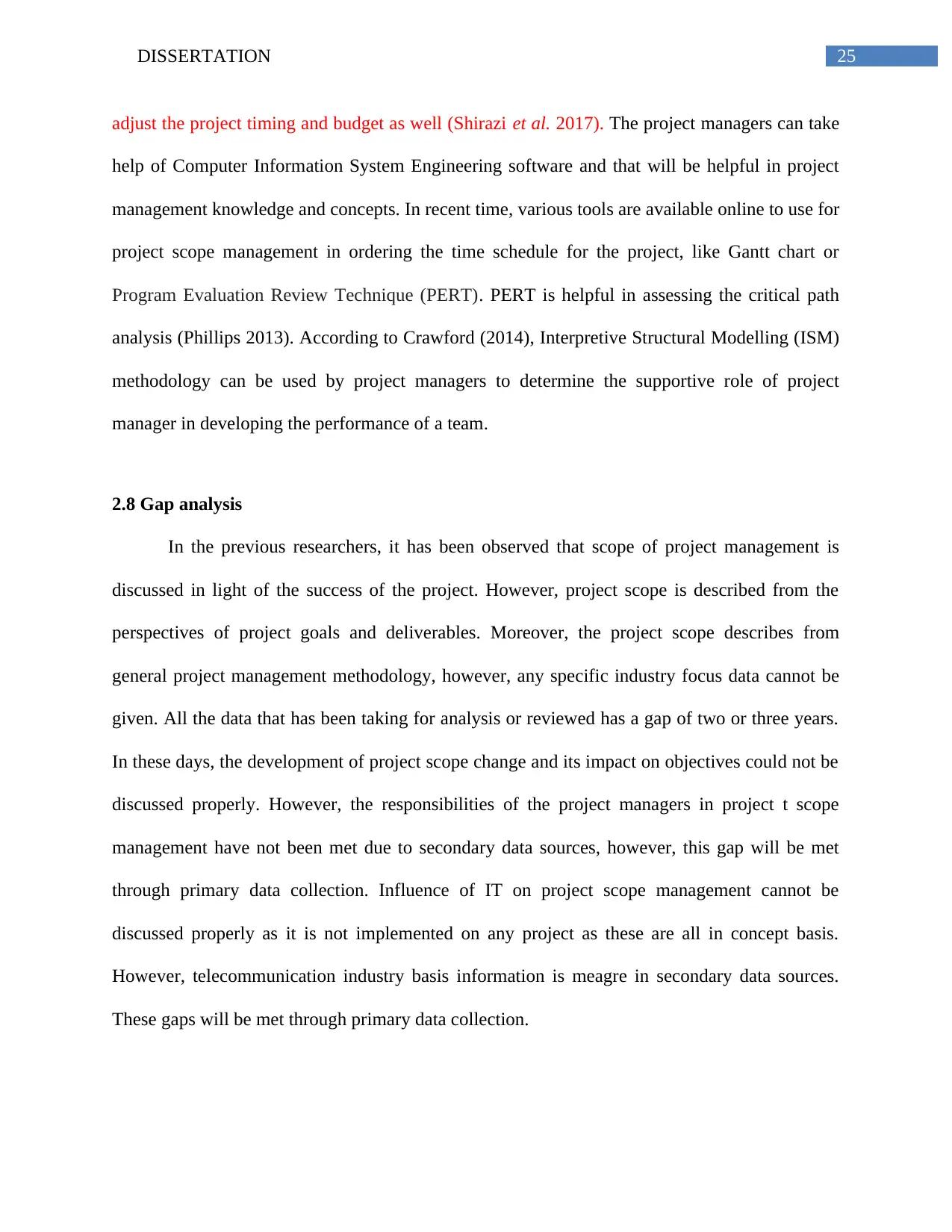
25DISSERTATION
adjust the project timing and budget as well (Shirazi et al. 2017). The project managers can take
help of Computer Information System Engineering software and that will be helpful in project
management knowledge and concepts. In recent time, various tools are available online to use for
project scope management in ordering the time schedule for the project, like Gantt chart or
Program Evaluation Review Technique (PERT). PERT is helpful in assessing the critical path
analysis (Phillips 2013). According to Crawford (2014), Interpretive Structural Modelling (ISM)
methodology can be used by project managers to determine the supportive role of project
manager in developing the performance of a team.
2.8 Gap analysis
In the previous researchers, it has been observed that scope of project management is
discussed in light of the success of the project. However, project scope is described from the
perspectives of project goals and deliverables. Moreover, the project scope describes from
general project management methodology, however, any specific industry focus data cannot be
given. All the data that has been taking for analysis or reviewed has a gap of two or three years.
In these days, the development of project scope change and its impact on objectives could not be
discussed properly. However, the responsibilities of the project managers in project t scope
management have not been met due to secondary data sources, however, this gap will be met
through primary data collection. Influence of IT on project scope management cannot be
discussed properly as it is not implemented on any project as these are all in concept basis.
However, telecommunication industry basis information is meagre in secondary data sources.
These gaps will be met through primary data collection.
adjust the project timing and budget as well (Shirazi et al. 2017). The project managers can take
help of Computer Information System Engineering software and that will be helpful in project
management knowledge and concepts. In recent time, various tools are available online to use for
project scope management in ordering the time schedule for the project, like Gantt chart or
Program Evaluation Review Technique (PERT). PERT is helpful in assessing the critical path
analysis (Phillips 2013). According to Crawford (2014), Interpretive Structural Modelling (ISM)
methodology can be used by project managers to determine the supportive role of project
manager in developing the performance of a team.
2.8 Gap analysis
In the previous researchers, it has been observed that scope of project management is
discussed in light of the success of the project. However, project scope is described from the
perspectives of project goals and deliverables. Moreover, the project scope describes from
general project management methodology, however, any specific industry focus data cannot be
given. All the data that has been taking for analysis or reviewed has a gap of two or three years.
In these days, the development of project scope change and its impact on objectives could not be
discussed properly. However, the responsibilities of the project managers in project t scope
management have not been met due to secondary data sources, however, this gap will be met
through primary data collection. Influence of IT on project scope management cannot be
discussed properly as it is not implemented on any project as these are all in concept basis.
However, telecommunication industry basis information is meagre in secondary data sources.
These gaps will be met through primary data collection.
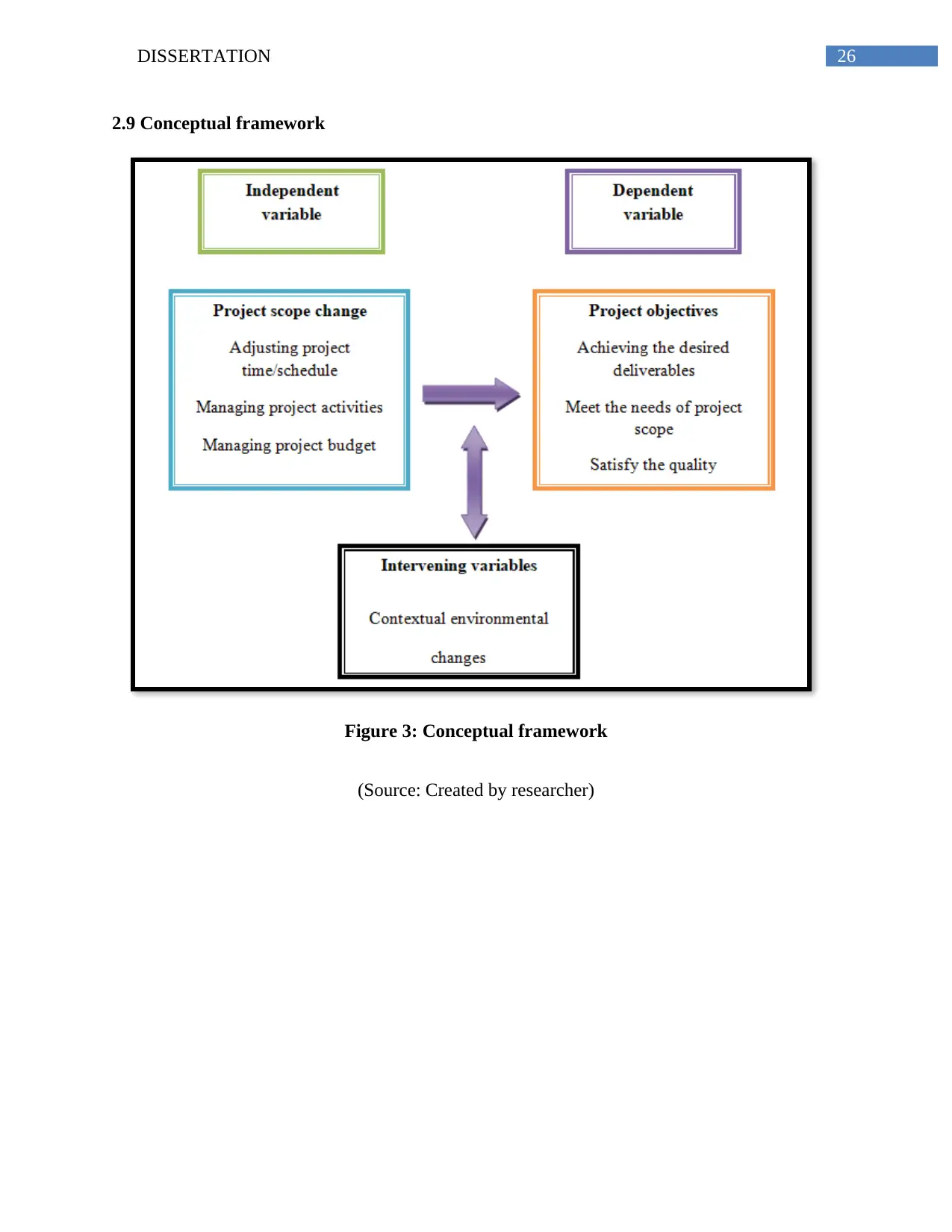
26DISSERTATION
2.9 Conceptual framework
Figure 3: Conceptual framework
(Source: Created by researcher)
2.9 Conceptual framework
Figure 3: Conceptual framework
(Source: Created by researcher)
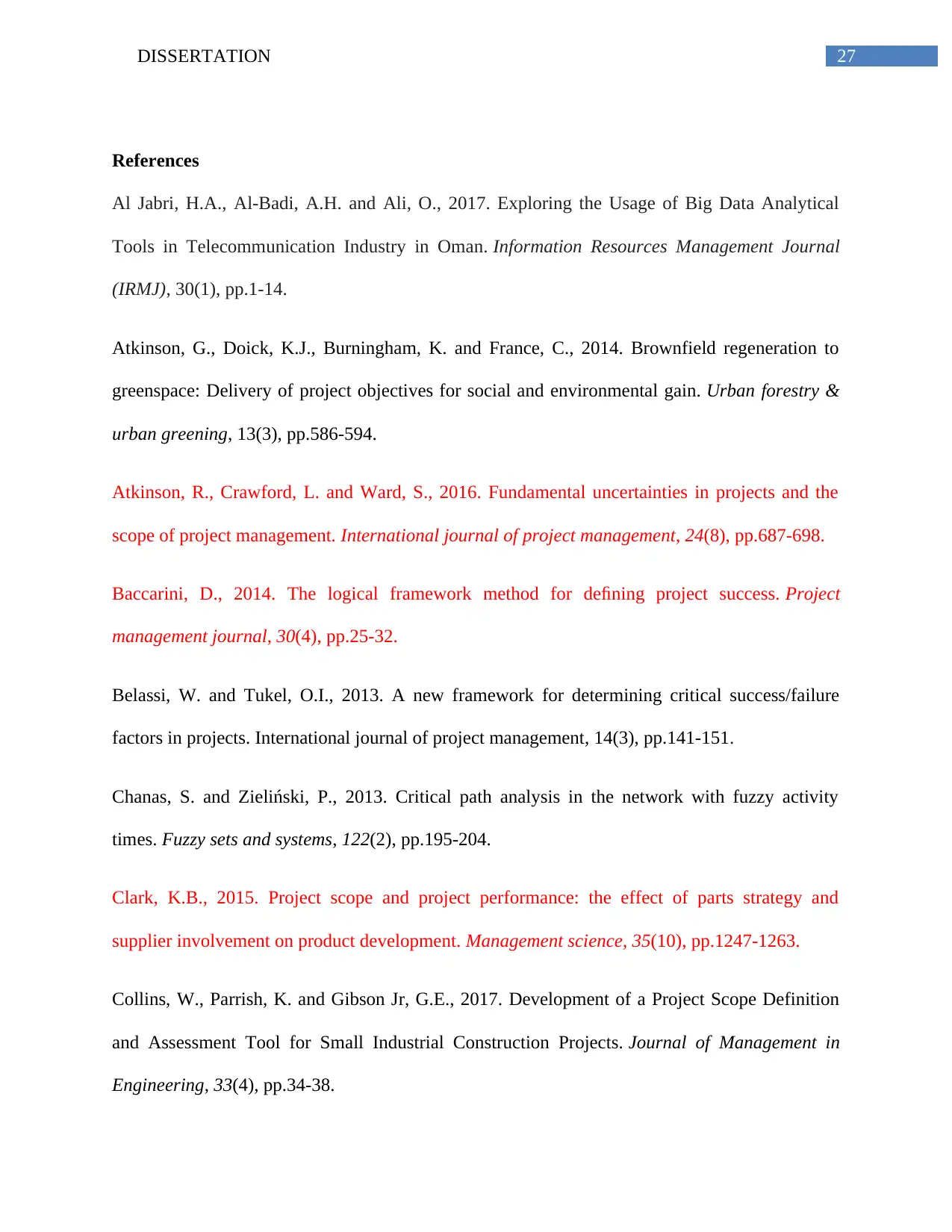
27DISSERTATION
References
Al Jabri, H.A., Al-Badi, A.H. and Ali, O., 2017. Exploring the Usage of Big Data Analytical
Tools in Telecommunication Industry in Oman. Information Resources Management Journal
(IRMJ), 30(1), pp.1-14.
Atkinson, G., Doick, K.J., Burningham, K. and France, C., 2014. Brownfield regeneration to
greenspace: Delivery of project objectives for social and environmental gain. Urban forestry &
urban greening, 13(3), pp.586-594.
Atkinson, R., Crawford, L. and Ward, S., 2016. Fundamental uncertainties in projects and the
scope of project management. International journal of project management, 24(8), pp.687-698.
Baccarini, D., 2014. The logical framework method for defining project success. Project
management journal, 30(4), pp.25-32.
Belassi, W. and Tukel, O.I., 2013. A new framework for determining critical success/failure
factors in projects. International journal of project management, 14(3), pp.141-151.
Chanas, S. and Zieliński, P., 2013. Critical path analysis in the network with fuzzy activity
times. Fuzzy sets and systems, 122(2), pp.195-204.
Clark, K.B., 2015. Project scope and project performance: the effect of parts strategy and
supplier involvement on product development. Management science, 35(10), pp.1247-1263.
Collins, W., Parrish, K. and Gibson Jr, G.E., 2017. Development of a Project Scope Definition
and Assessment Tool for Small Industrial Construction Projects. Journal of Management in
Engineering, 33(4), pp.34-38.
References
Al Jabri, H.A., Al-Badi, A.H. and Ali, O., 2017. Exploring the Usage of Big Data Analytical
Tools in Telecommunication Industry in Oman. Information Resources Management Journal
(IRMJ), 30(1), pp.1-14.
Atkinson, G., Doick, K.J., Burningham, K. and France, C., 2014. Brownfield regeneration to
greenspace: Delivery of project objectives for social and environmental gain. Urban forestry &
urban greening, 13(3), pp.586-594.
Atkinson, R., Crawford, L. and Ward, S., 2016. Fundamental uncertainties in projects and the
scope of project management. International journal of project management, 24(8), pp.687-698.
Baccarini, D., 2014. The logical framework method for defining project success. Project
management journal, 30(4), pp.25-32.
Belassi, W. and Tukel, O.I., 2013. A new framework for determining critical success/failure
factors in projects. International journal of project management, 14(3), pp.141-151.
Chanas, S. and Zieliński, P., 2013. Critical path analysis in the network with fuzzy activity
times. Fuzzy sets and systems, 122(2), pp.195-204.
Clark, K.B., 2015. Project scope and project performance: the effect of parts strategy and
supplier involvement on product development. Management science, 35(10), pp.1247-1263.
Collins, W., Parrish, K. and Gibson Jr, G.E., 2017. Development of a Project Scope Definition
and Assessment Tool for Small Industrial Construction Projects. Journal of Management in
Engineering, 33(4), pp.34-38.
Secure Best Marks with AI Grader
Need help grading? Try our AI Grader for instant feedback on your assignments.
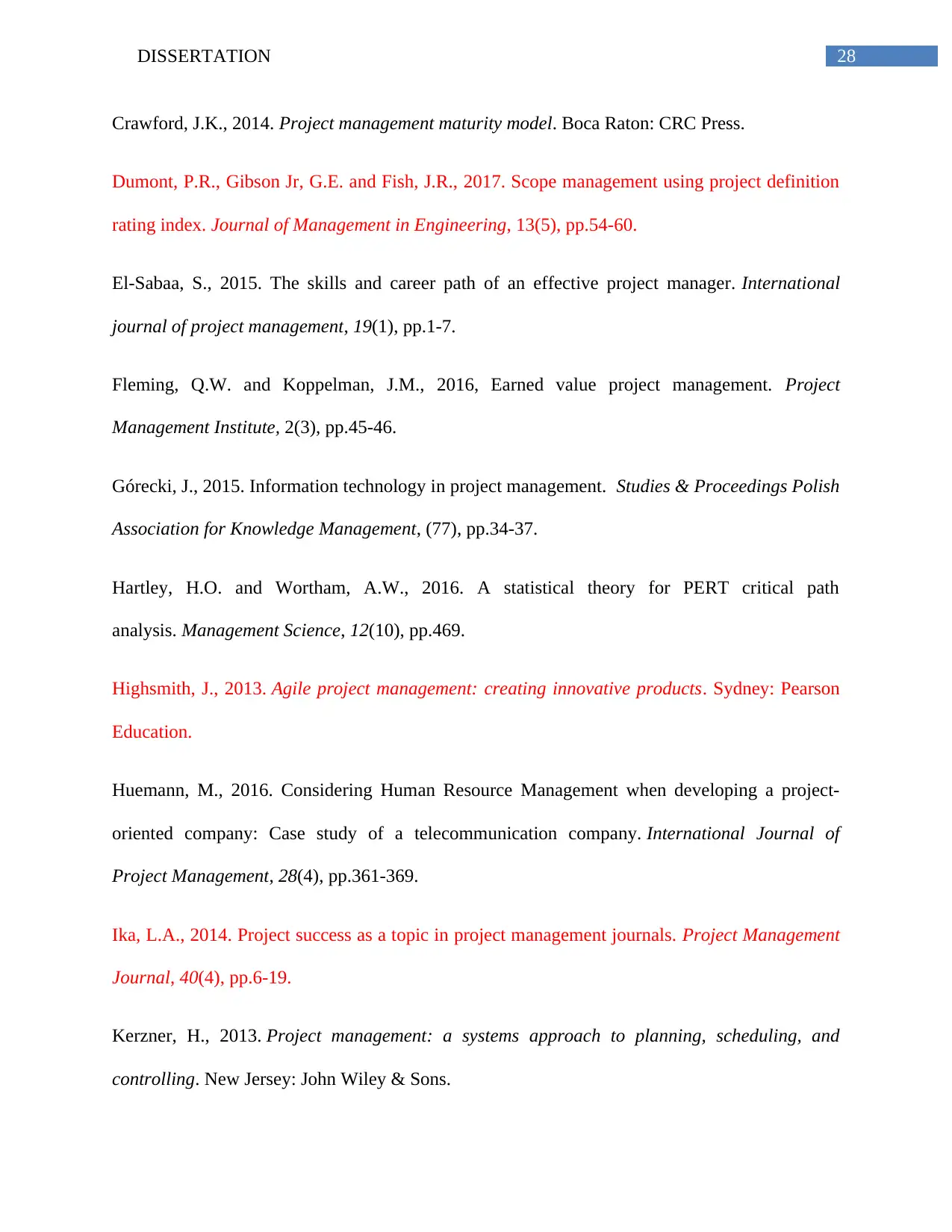
28DISSERTATION
Crawford, J.K., 2014. Project management maturity model. Boca Raton: CRC Press.
Dumont, P.R., Gibson Jr, G.E. and Fish, J.R., 2017. Scope management using project definition
rating index. Journal of Management in Engineering, 13(5), pp.54-60.
El-Sabaa, S., 2015. The skills and career path of an effective project manager. International
journal of project management, 19(1), pp.1-7.
Fleming, Q.W. and Koppelman, J.M., 2016, Earned value project management. Project
Management Institute, 2(3), pp.45-46.
Górecki, J., 2015. Information technology in project management. Studies & Proceedings Polish
Association for Knowledge Management, (77), pp.34-37.
Hartley, H.O. and Wortham, A.W., 2016. A statistical theory for PERT critical path
analysis. Management Science, 12(10), pp.469.
Highsmith, J., 2013. Agile project management: creating innovative products. Sydney: Pearson
Education.
Huemann, M., 2016. Considering Human Resource Management when developing a project-
oriented company: Case study of a telecommunication company. International Journal of
Project Management, 28(4), pp.361-369.
Ika, L.A., 2014. Project success as a topic in project management journals. Project Management
Journal, 40(4), pp.6-19.
Kerzner, H., 2013. Project management: a systems approach to planning, scheduling, and
controlling. New Jersey: John Wiley & Sons.
Crawford, J.K., 2014. Project management maturity model. Boca Raton: CRC Press.
Dumont, P.R., Gibson Jr, G.E. and Fish, J.R., 2017. Scope management using project definition
rating index. Journal of Management in Engineering, 13(5), pp.54-60.
El-Sabaa, S., 2015. The skills and career path of an effective project manager. International
journal of project management, 19(1), pp.1-7.
Fleming, Q.W. and Koppelman, J.M., 2016, Earned value project management. Project
Management Institute, 2(3), pp.45-46.
Górecki, J., 2015. Information technology in project management. Studies & Proceedings Polish
Association for Knowledge Management, (77), pp.34-37.
Hartley, H.O. and Wortham, A.W., 2016. A statistical theory for PERT critical path
analysis. Management Science, 12(10), pp.469.
Highsmith, J., 2013. Agile project management: creating innovative products. Sydney: Pearson
Education.
Huemann, M., 2016. Considering Human Resource Management when developing a project-
oriented company: Case study of a telecommunication company. International Journal of
Project Management, 28(4), pp.361-369.
Ika, L.A., 2014. Project success as a topic in project management journals. Project Management
Journal, 40(4), pp.6-19.
Kerzner, H., 2013. Project management: a systems approach to planning, scheduling, and
controlling. New Jersey: John Wiley & Sons.
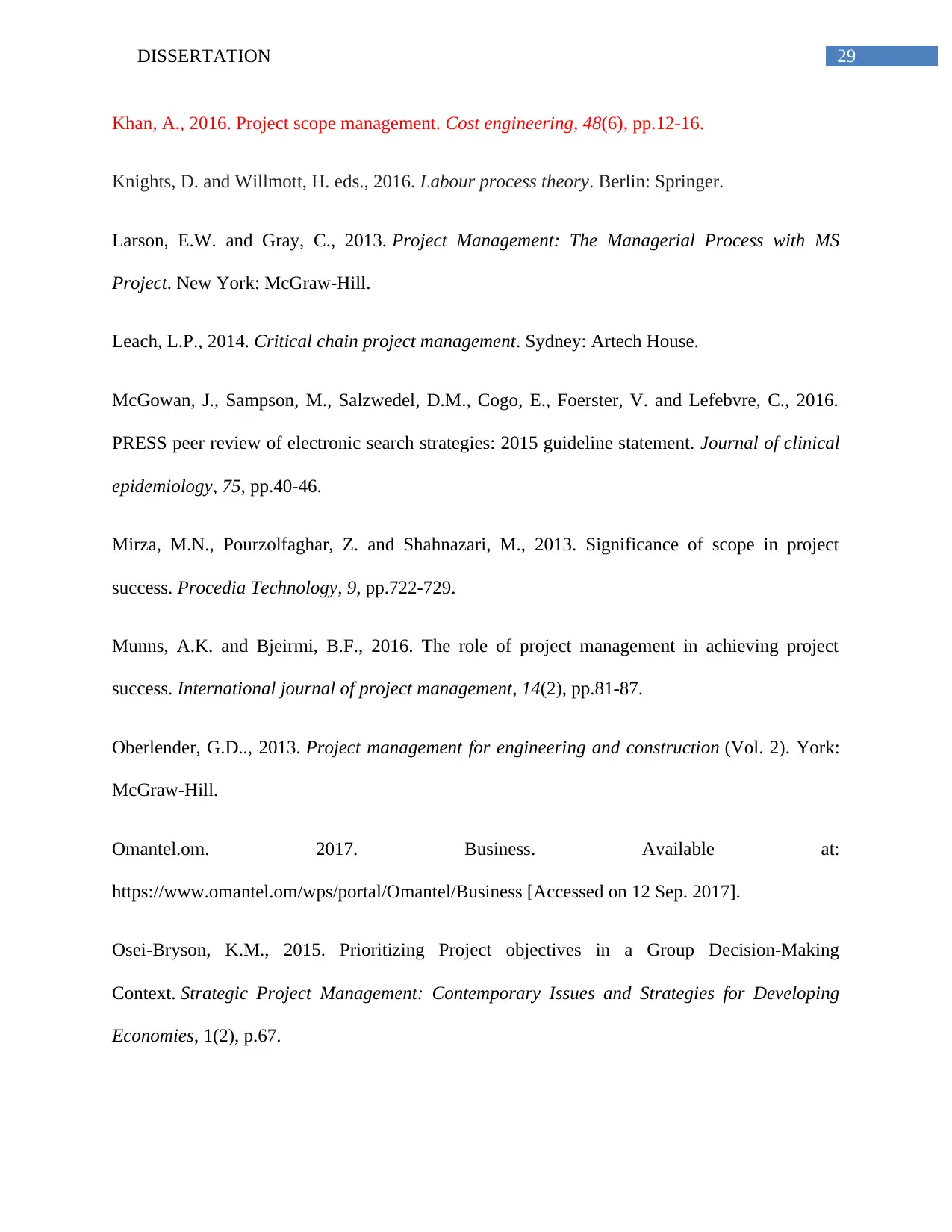
29DISSERTATION
Khan, A., 2016. Project scope management. Cost engineering, 48(6), pp.12-16.
Knights, D. and Willmott, H. eds., 2016. Labour process theory. Berlin: Springer.
Larson, E.W. and Gray, C., 2013. Project Management: The Managerial Process with MS
Project. New York: McGraw-Hill.
Leach, L.P., 2014. Critical chain project management. Sydney: Artech House.
McGowan, J., Sampson, M., Salzwedel, D.M., Cogo, E., Foerster, V. and Lefebvre, C., 2016.
PRESS peer review of electronic search strategies: 2015 guideline statement. Journal of clinical
epidemiology, 75, pp.40-46.
Mirza, M.N., Pourzolfaghar, Z. and Shahnazari, M., 2013. Significance of scope in project
success. Procedia Technology, 9, pp.722-729.
Munns, A.K. and Bjeirmi, B.F., 2016. The role of project management in achieving project
success. International journal of project management, 14(2), pp.81-87.
Oberlender, G.D.., 2013. Project management for engineering and construction (Vol. 2). York:
McGraw-Hill.
Omantel.om. 2017. Business. Available at:
https://www.omantel.om/wps/portal/Omantel/Business [Accessed on 12 Sep. 2017].
Osei-Bryson, K.M., 2015. Prioritizing Project objectives in a Group Decision-Making
Context. Strategic Project Management: Contemporary Issues and Strategies for Developing
Economies, 1(2), p.67.
Khan, A., 2016. Project scope management. Cost engineering, 48(6), pp.12-16.
Knights, D. and Willmott, H. eds., 2016. Labour process theory. Berlin: Springer.
Larson, E.W. and Gray, C., 2013. Project Management: The Managerial Process with MS
Project. New York: McGraw-Hill.
Leach, L.P., 2014. Critical chain project management. Sydney: Artech House.
McGowan, J., Sampson, M., Salzwedel, D.M., Cogo, E., Foerster, V. and Lefebvre, C., 2016.
PRESS peer review of electronic search strategies: 2015 guideline statement. Journal of clinical
epidemiology, 75, pp.40-46.
Mirza, M.N., Pourzolfaghar, Z. and Shahnazari, M., 2013. Significance of scope in project
success. Procedia Technology, 9, pp.722-729.
Munns, A.K. and Bjeirmi, B.F., 2016. The role of project management in achieving project
success. International journal of project management, 14(2), pp.81-87.
Oberlender, G.D.., 2013. Project management for engineering and construction (Vol. 2). York:
McGraw-Hill.
Omantel.om. 2017. Business. Available at:
https://www.omantel.om/wps/portal/Omantel/Business [Accessed on 12 Sep. 2017].
Osei-Bryson, K.M., 2015. Prioritizing Project objectives in a Group Decision-Making
Context. Strategic Project Management: Contemporary Issues and Strategies for Developing
Economies, 1(2), p.67.
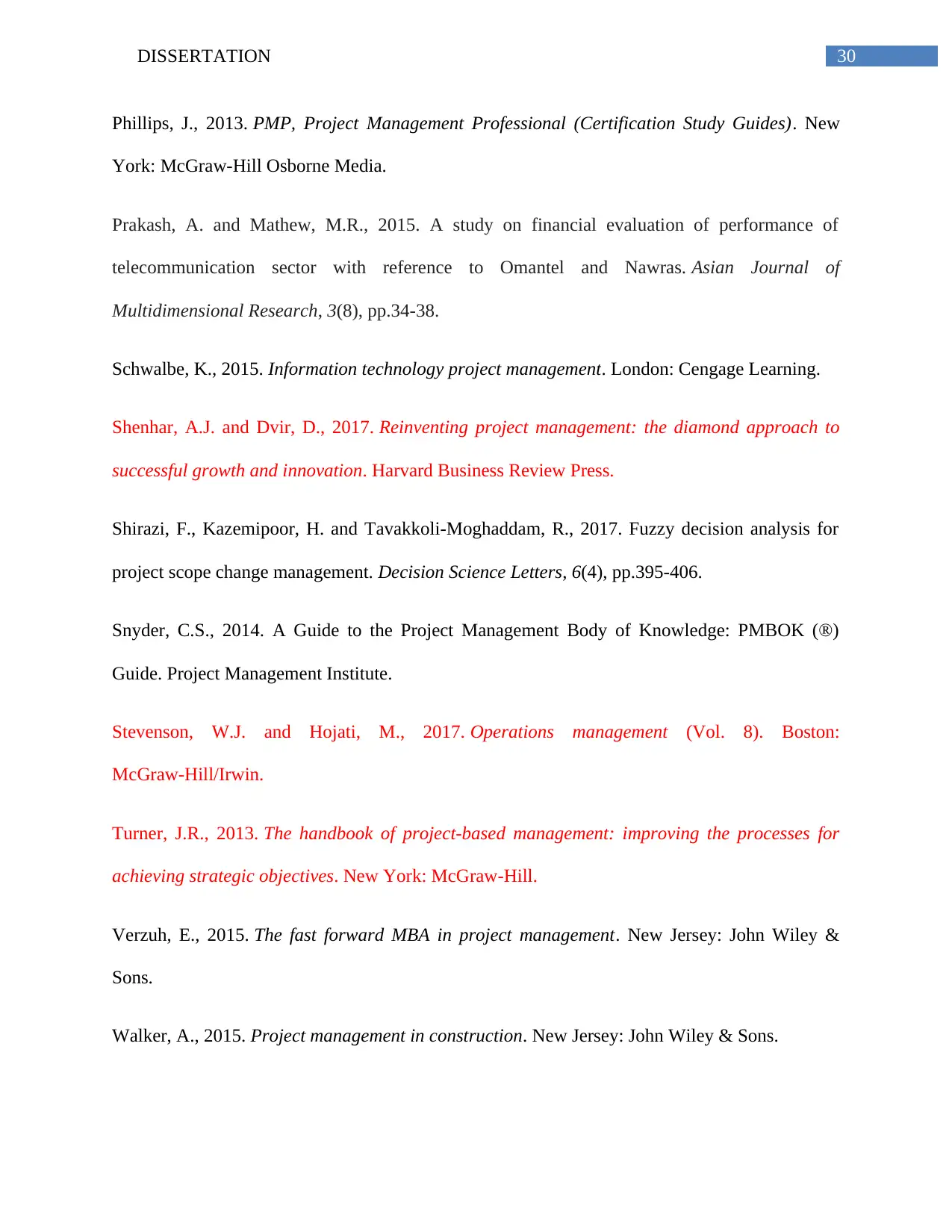
30DISSERTATION
Phillips, J., 2013. PMP, Project Management Professional (Certification Study Guides). New
York: McGraw-Hill Osborne Media.
Prakash, A. and Mathew, M.R., 2015. A study on financial evaluation of performance of
telecommunication sector with reference to Omantel and Nawras. Asian Journal of
Multidimensional Research, 3(8), pp.34-38.
Schwalbe, K., 2015. Information technology project management. London: Cengage Learning.
Shenhar, A.J. and Dvir, D., 2017. Reinventing project management: the diamond approach to
successful growth and innovation. Harvard Business Review Press.
Shirazi, F., Kazemipoor, H. and Tavakkoli-Moghaddam, R., 2017. Fuzzy decision analysis for
project scope change management. Decision Science Letters, 6(4), pp.395-406.
Snyder, C.S., 2014. A Guide to the Project Management Body of Knowledge: PMBOK (®)
Guide. Project Management Institute.
Stevenson, W.J. and Hojati, M., 2017. Operations management (Vol. 8). Boston:
McGraw-Hill/Irwin.
Turner, J.R., 2013. The handbook of project-based management: improving the processes for
achieving strategic objectives. New York: McGraw-Hill.
Verzuh, E., 2015. The fast forward MBA in project management. New Jersey: John Wiley &
Sons.
Walker, A., 2015. Project management in construction. New Jersey: John Wiley & Sons.
Phillips, J., 2013. PMP, Project Management Professional (Certification Study Guides). New
York: McGraw-Hill Osborne Media.
Prakash, A. and Mathew, M.R., 2015. A study on financial evaluation of performance of
telecommunication sector with reference to Omantel and Nawras. Asian Journal of
Multidimensional Research, 3(8), pp.34-38.
Schwalbe, K., 2015. Information technology project management. London: Cengage Learning.
Shenhar, A.J. and Dvir, D., 2017. Reinventing project management: the diamond approach to
successful growth and innovation. Harvard Business Review Press.
Shirazi, F., Kazemipoor, H. and Tavakkoli-Moghaddam, R., 2017. Fuzzy decision analysis for
project scope change management. Decision Science Letters, 6(4), pp.395-406.
Snyder, C.S., 2014. A Guide to the Project Management Body of Knowledge: PMBOK (®)
Guide. Project Management Institute.
Stevenson, W.J. and Hojati, M., 2017. Operations management (Vol. 8). Boston:
McGraw-Hill/Irwin.
Turner, J.R., 2013. The handbook of project-based management: improving the processes for
achieving strategic objectives. New York: McGraw-Hill.
Verzuh, E., 2015. The fast forward MBA in project management. New Jersey: John Wiley &
Sons.
Walker, A., 2015. Project management in construction. New Jersey: John Wiley & Sons.
1 out of 31
Related Documents
Your All-in-One AI-Powered Toolkit for Academic Success.
+13062052269
info@desklib.com
Available 24*7 on WhatsApp / Email
![[object Object]](/_next/static/media/star-bottom.7253800d.svg)
Unlock your academic potential
© 2024 | Zucol Services PVT LTD | All rights reserved.





